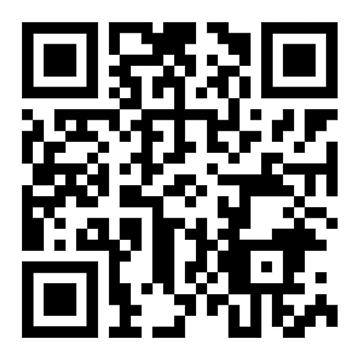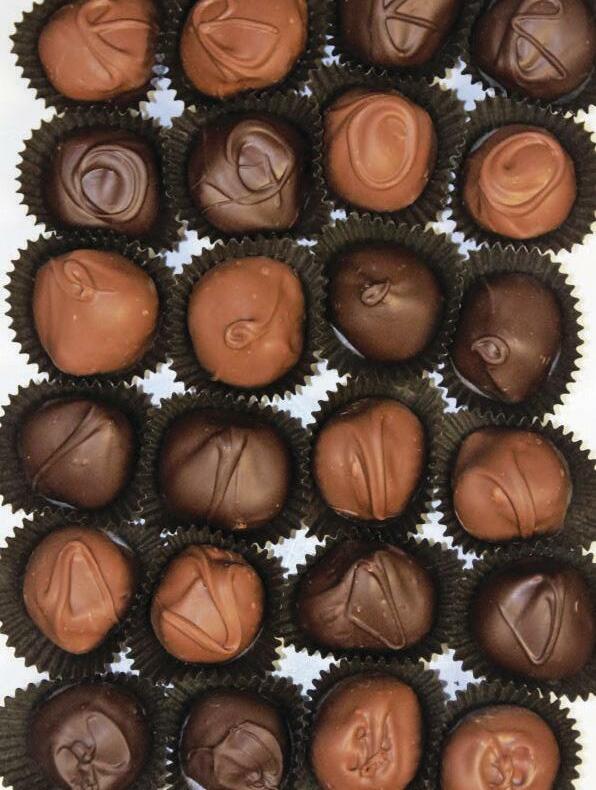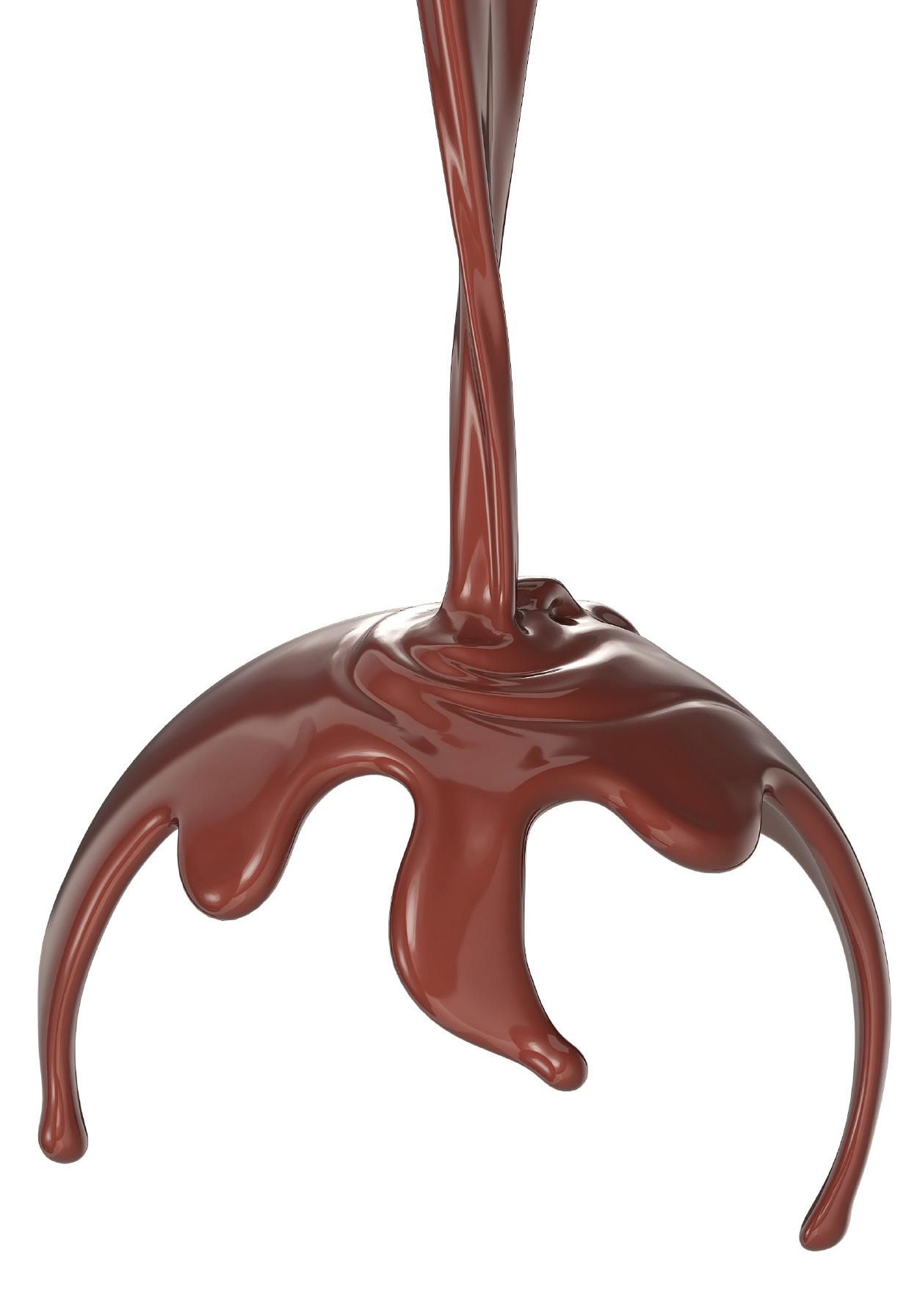SENSES
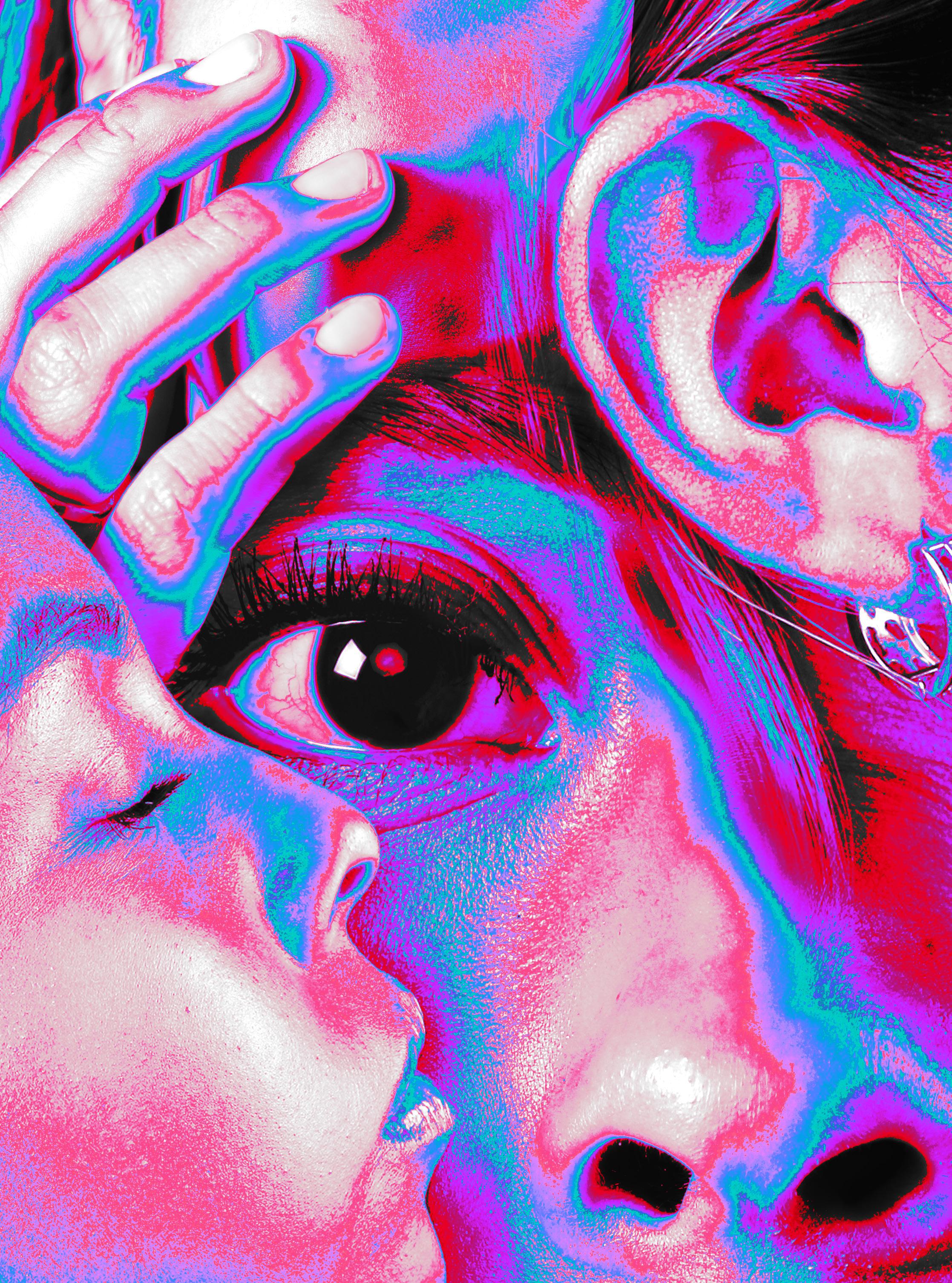




Staff List
Meet our team.
How this issues’ theme was developed.
Looking back at stories that took you through the five senses and the many ways they impact our lives.
The unexplainable inspiration behind the canvases of senior art students is the “gut feeling” of being an artist.
 By Kami Geron
By Kami Geron

The senses play a pivotal role in how the body navigates PTSD.
By Tori Smith 22How music platforms have changed the industry for independent artists.
By Haley BoyceHow scent connects us to the places and people we love.
26 Contents By Zach Gonzalez
By Zach Gonzalez
Turnstone Center provides vital services for the disabled community.
By Madelyn BrackenBy Daniela Morales
By Sarah Olsen
Baby cuddlers and medical experts discuss the benefits of physical contact with premature babies.
 By Brianna Morton
By Brianna Morton
A glimpse into the many different types of color blindness.
Adcock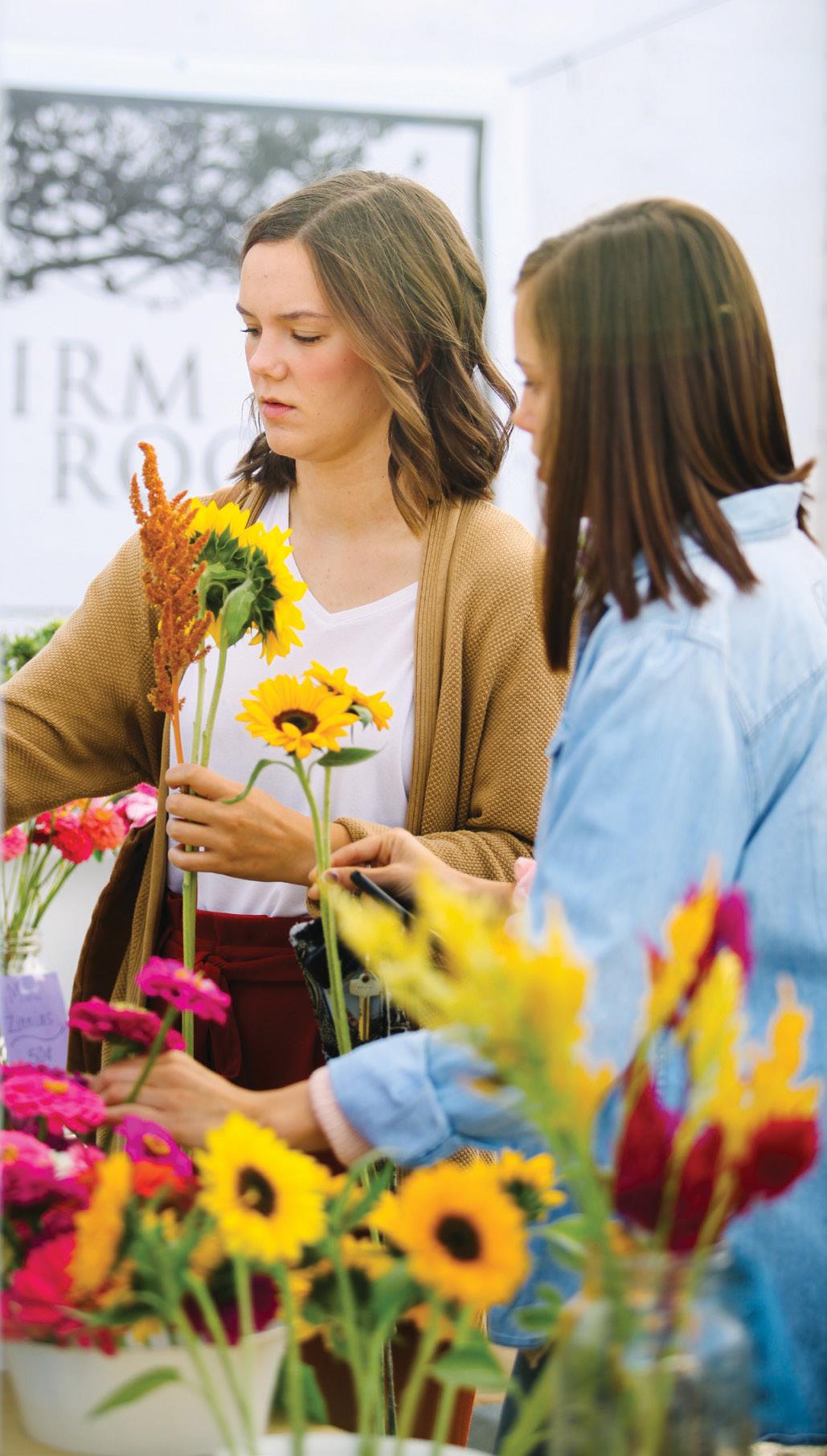
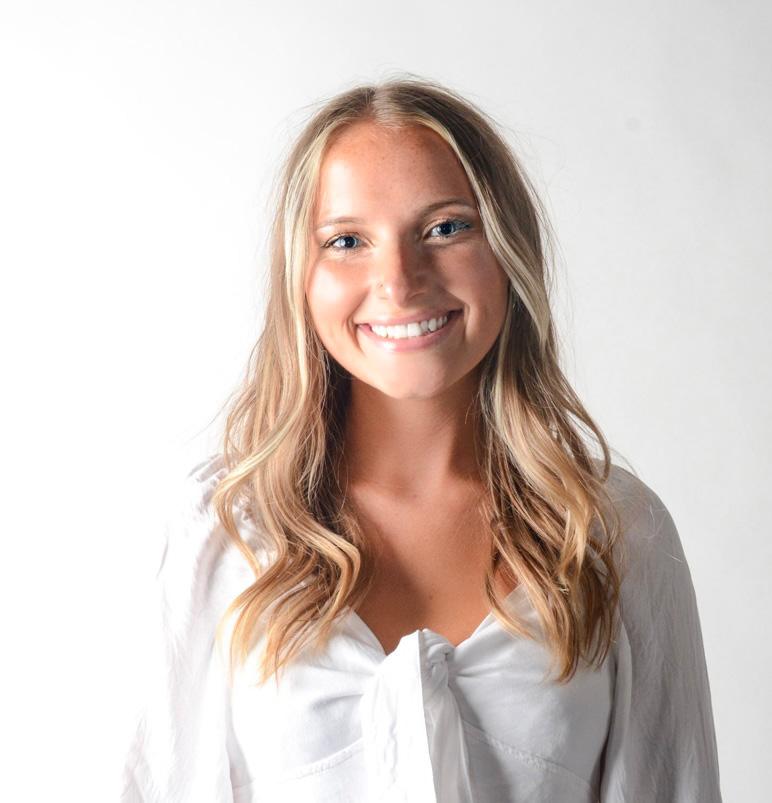 Editor-in-chief hgboyce@bsu.edu | @lala_haley
Editor-in-chief hgboyce@bsu.edu | @lala_haley
When I think about the five senses, a flood of memories comes back to me.
I think about middle school, and the overwhelming smell of dollar store perfume and Axe Body Spray, slowly spreading in the halls and locker rooms. I think about the special breakfast treat my mom makes every Christmas morning. The dough and sugar that melts on your tongue makes the holiday all the more merry.
I think about my sweet rescue dogs who jump into my arms when I come home for a break and lick my tears when I’m going through heartbreak. I think about my first One Direction concert and the way my ears rang after. I think about my toddler self getting my first set of glasses, purple with a tiny bead of Princess Jasmine dangling off the side, finally being able to see clearly.
Our senses hold so much power. They fill us with emotions and memories, allowing us to feel connected to people, places, food, images, and more. They’re fickle and like to be comedians every now and then. One time when I was alone walking on campus, I got a strong whiff of an ex-boyfriend’s cologne. No one was around me. I scrunched up my nose and thought, “Huh. My senses must think they’re funny.”
For Ball Bearings’ Fall 2022 issue we wanted to remind you of just how powerful our senses are and all that they can unlock. When we were brainstorming ideas, our staff found that we all have distinct feelings that go along with a certain sense. For our managing editor, Daniela, she feels joy thinking about the smell of brownies baking in the oven. For Alex, our co-art director, he feels disgusted when thinking about the taste of cottage cheese.
As a staff, our workspace has its own set of senses entangled with memories and feelings. We get to watch the leaves fall and the sun set out the windows of the Unified Media Lab. We have the pleasure of getting to smell and taste Chick-fil-A as much as we want, thanks to the Atrium being right below our feet. We touch and tap our keyboards and mouses. We hear each other share our days, oftentimes resulting in one of my favorite sound: laughter.
In this issue, our award-winning, student-run magazine explores concepts such as how your senses are impacted when you’re intoxicated, how PTSD can be triggered by your senses, how baby cuddlers are making a difference for newborns in the NICU, and more.
Something I’ve learned is that you can trick your senses into bringing you peace. When I’m stressed or sad I like to use my senses to transport me somewhere warm and happy - the beach. I can feel the sun and sand on my skin, smell the sunscreen and saltwater in the air, and hear the waves crashing. So, use your senses and transport yourself to your happy place as you read our magazine. I hope this issue brings you nothing but happy memories full of delicious tastes, warm touches, aromatic scents, beautiful sights and sweet songs. g
Our senses hold so much power. They fill us with emotions and memories, allowing us to feel connected to people, places, food, images, and more.”
Music is not only experienced physically – it also plays an important role socially.
 By Tori Smith
By Tori Smith
It’s a crisp fall day, and concertgoers file into a dim auditorium, eager to feel 20,000 to 30,000 of their ear’s hair cells vibrate. They may not know it, but those hair cells react to the tones and pitches of the music, translating vibrations into electrical signals that can be interpreted by the brain.
Although we are able to hear all elements while listening to music, we’re likely to catch onto melody the most, according to Eleanor Trawick.
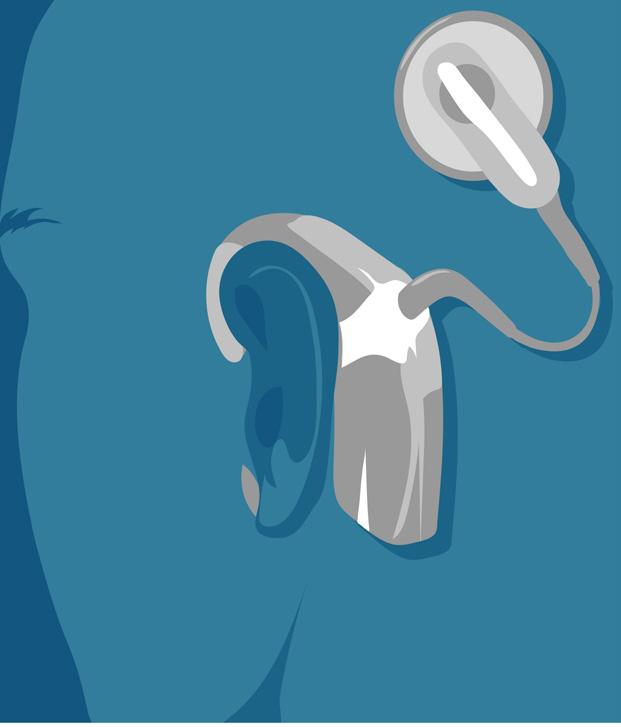
Ball State students share their stories about hearing struggles.
By Maya WilkinsIt’s difficult for Monet Lindstrand to feel like a member of the Deaf community.
The third-year Ball State student is missing the hairs on her cochleae — the hairs that vibrate when sound passes through the ear drums so the brain can process the noise. Those hairs have always been missing; she was born that way.
Preview the stories that took you through the five senses and the many ways they impact our lives.
James Turner’s wife, Linda, lost most of her hearing due to nerve damage when she was a child. Linda’s hearing became much worse when she was about 35 years old, James says, but they were able to find a device from RadioShack called The Listenator to help her hear better.
In 2005, James and his wife adopted Nekayah, a Louisiana Catahoula Shepherd. James says when Nekayah was about a year old, he called a service animal trainer in Indianapolis who taught James how to train Nekayah to become a service dog for his wife.

Game nights — they’re arguably one of the best ways to bring people together. Perfect for a date night, family bonding, or just a hangout with friends, board games can show off someone’s playful, competitive side.

There are a wide variety of different board games on the market. Some have complex directions with several little game pieces, while others are more simple with an easy goal and few accessories.
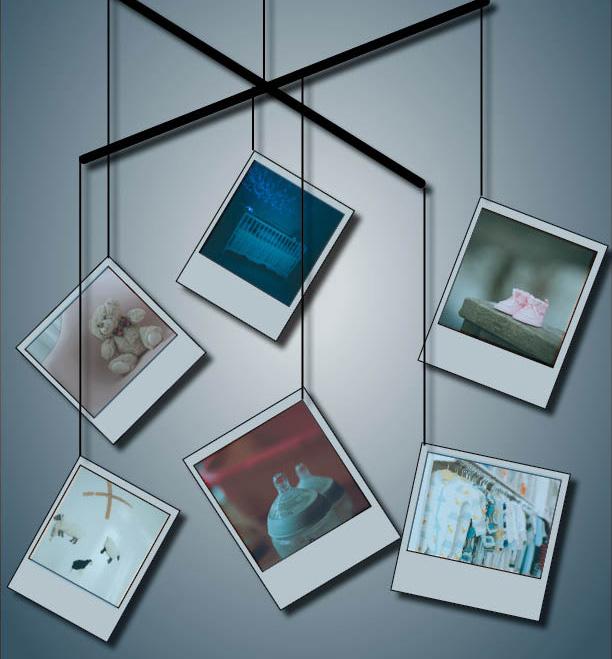
After giving birth to her stillborn son at 30 years old, Molly McGuire, Ball State alumna, remembers little about her experience. It wasn’t until being in the same hospital room while preparing to deliver her daughter, that she noticed her ex-partner’s anxiety was increasing. While Molly didn’t remember the room at all, her ex-partner vividly did.
Trauma can impact an individual’s memory greatly, and a traumatic experience can also affect the nervous system and body.
How the brain and the senses can alter the recollection of trauma.
Five board games that will awaken your sense.
How different training techniques teach dogs how to communicate with sound.
Read
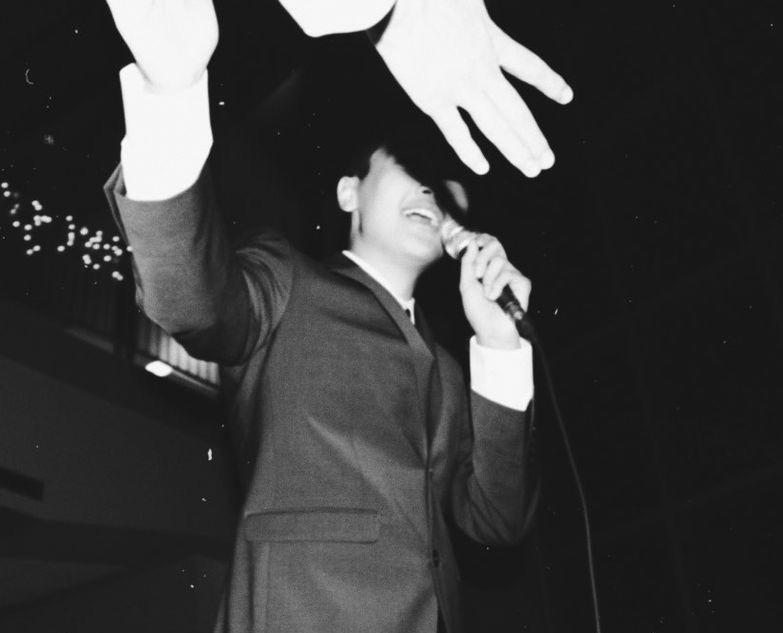
Bachka Batjargel was finally ready. He made his account several weeks prior to his first ever release. He wanted to feel better about himself and actually release a song. He had some songs in his personal “vault” that he wanted to show off to a few of his friends.
And he was ready. It was 2017. He had watched two other rappers start to blow up on SoundCloud. So, he got it. It was surprisingly easy to sign up and use. He made his account, uploaded his song and showed it to five of his friends.

When he woke up the next day, his upload had 30 streams. He remembers feeling surprised, but the extra 25 streams was a big enough push to make him want to keep going. He remembers asking himself: “What’s stopping me from uploading more?”
Bachka, a Ball State third-year student who uses his first name as his stage name, is one of more than 30 million artists who have uploaded music to SoundCloud. SoundCloud was founded in 2008 as an online platform where independent artists could upload their music and listeners could indulge in their favorite artists while discovering lesser known musicians.
There have been several artists who accelerated their careers through uploading their music on SoundCloud. One example of this is Symere Woods, actually known as Lil Uzi Vert.
Lil Uzi Vert started uploading music to their SoundCloud account in 2014. By 2016, they were the most followed artist on the platform.
Germaine “B Swift” Russell, an Assistant Program Director at WHHH HOT 100.9 based out of Indianapolis, has been working in radio for a little over 18 years. He views SoundCloud as a complete gamechanger for the
“Some of the biggest songs have started on SoundCloud and other sites that eventually fell in our laps and grew to a hit,” he says.
- Bachka, Rap artistRapper Fetty Wap’s 2014 song “Trap Queen” is just one example of a song that was originally uploaded to SoundCloud and later took off, having success on the radio.
Since uploading his first song, Bachka has released seven albums and expanded his music to platforms like Spotify and Apple Music. His most successful song reached over 800,000 streams on Spotify alone. He credits the high amount of streams to a TikTok audio that was trending at the time.
“It’s because I sampled [the audio], ‘I just want to be the one you love,’ which was around the time that it started blowing up,” Bachka explains. “Because of that, people would search for the title of ‘I just want to be the one you love’ and I had a [trilogy of albums named that.] Next thing you know, people started going to that song.”
Social media apps such as TikTok play a big role within the music industry. B Swift says he uses apps like TikTok to decide what to play on the radio.
“Research is the biggest thing,” B Swift says. “I’m on Shazam, TikTok, [and] Billboards Media Base.” An example of when B Swift utilized his tools was when the song “Bad Habit” by Steve Lacy started to rise in popularity. He had never heard the song, but noticed it was number one on Shazam’s Indianapolis Charts.
“At that point, it was like ‘Yo we are missing something here. Let’s support it,’” B Swift recalls saying. “It took me doing some research and seeing how real this song is before even bringing it up for any type of play.”
How music platforms have changed the industry for independent artists.
What’s stopping me from uploading more?”
Certain music apps have features that can help independent artists get discovered. One example of this is Spotify. Spotify crafts playlists that feature independent artists. Bachka has utilized Spotify to push his music out to a wider audience and believes it’s the streaming platform that has given him the most success.
“Whenever you do make a release, they automatically send out an email telling [listeners] you have a new release and what not,” he says. “There’s an option on Spotify to actually submit your songs to playlist curators. If they really enjoy what they’re hearing, they can actually submit [your song] to big playlists by Spotify.”
Christian hip-hop shows and events. In the past, Hyphy and Holy has performed at places like MadJax in Muncie and various churches near the Muncie and Anderson area.
While BlueGiraffeKid has found success in producing music and hosting events, he feels like there’s a stigma associated with starting a music career on SoundCloud.
There’s a certain term for this stigma: SoundCloud rapper.
“SoundCloud rapper has become synonymous with trash,” he says. “I think whenever I hear ‘SoundCloud rapper’, I just think of kids in high school.”
BlueGiraffeKid knows the typical comments people make when someone reveals they make music on SoundCloud.
“Oh, you’re not a professional.”
BlueGiraffeKid performs with Rome Herbert at a Hyphy and Holy event in Anderson, Ind.
BlueGiraffeKid, Photo Provided
“I think if you’re putting your music on Spotify and Apple Music, you should also put your music on SoundCloud because people listen to that,” BlueGiraffeKid says. “For years, that’s all I listened to.”
Moving forward, BlueGiraffeKid wants to make producing music into his full time career.
“One of the most beautiful things about music is that it’s a universal language,” he says. “If I make a song and you speak a different language, you might not know what the song is saying, but you can still dance to it.”
Kieran Simmer, a Ball State senior who goes by BlueGiraffeKid, is a producer who got his start on SoundCloud. Similar to Bachka, he has since expanded his work to streaming sites like Spotify and Apple Music.
BlueGiraffeKid first became interested in music when he began taking drum lessons at age 10. At 12 years old, he started producing music and hasn’t stopped since. Aside from producing music, he’s also a part of a group called Hyphy and Holy.
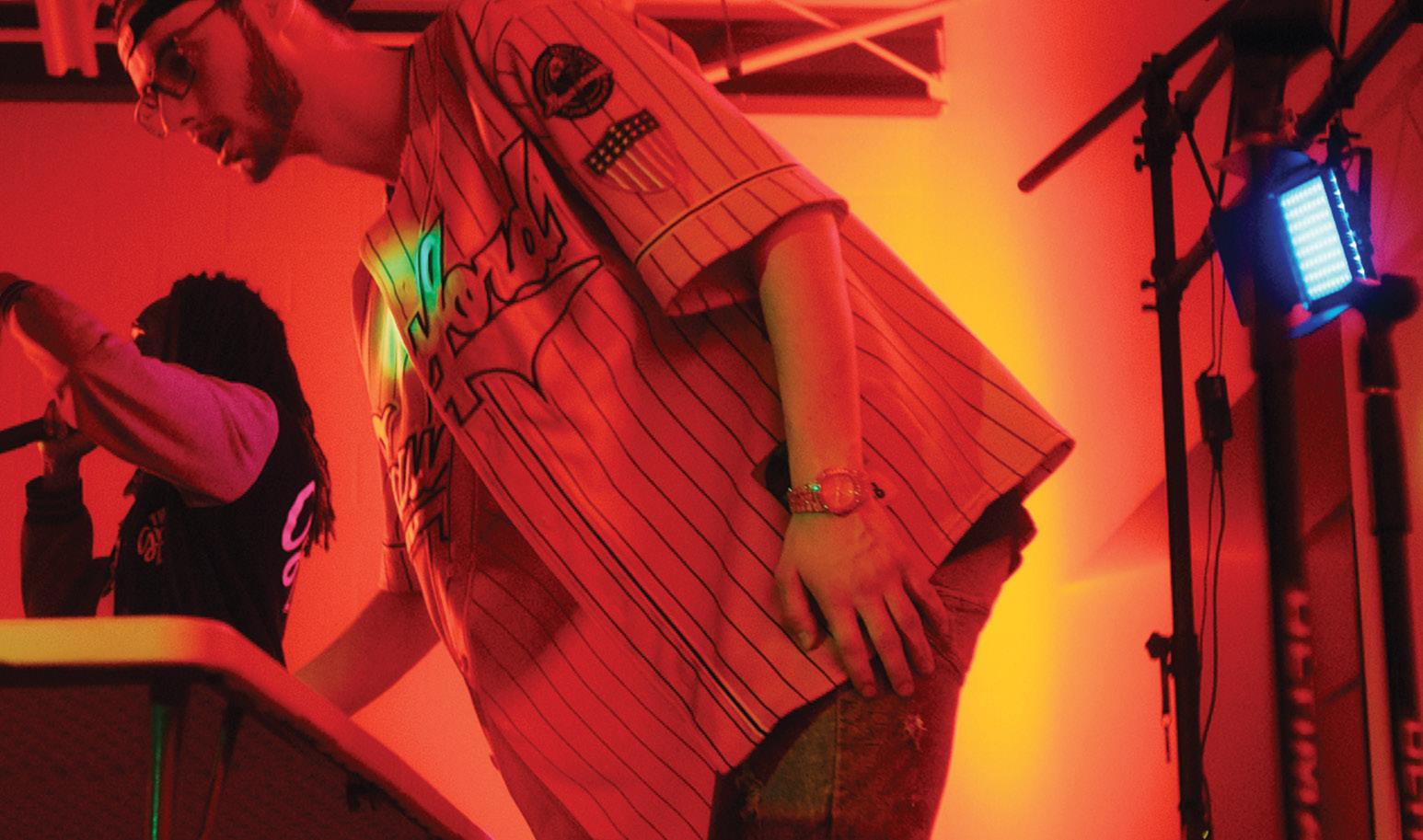
The group travels around to different churches in the Indiana area and holds
“You’re not doing your stuff right.” “There’s a level of saying it’s a beginner thing and that isn’t wrong,” he says. “It doesn’t seem like you’re official if you put yourself on there. That’s where the trash stigma comes from. Because anyone can do it. It’s not impressive anymore.”
Despite the stigma, BlueGiraffeKid still vouches for SoundCloud and its accessibility and possibility of discovery.
SoundCloud is still getting traffic. According to SimilarWeb, a company that specializes in website engagement and analytics, the platform had over 121 million visits alone in August 2022.
For Bachka, his goal with music is to collaborate with other creators more and keep making music he’s proud of. If making a career off music isn’t possible, he’d still love to make music on the side.
B Swift advises any artist struggling to break out to just do what’s best for them.
“Everybody’s journey is different,” he says. “Don’t give up. Pay attention to all the tools that you have for free that give you information and help you build stories.”
To learn more about Bachka and his music, listeners can find him on Instagram at @bachka317. To learn more about BlueGiraffeKid and his music, listeners can find him on Instagram at @bluegiraffekid. g
One of the most beautiful things about music is that it’s a universal language.
- BlueGiraffeKid, ProducerBy Zach Gonzalez
Throughout the globe, scents overflow people’s cultural lives. From the smell of vivid, pleasant flowers to the taste of scrumptious, stomach-filling food, scents provide us with various meanings and pleasures to life.
Each cultural lifestyle offers something new to the table, which means the senses involved in each country’s collective palate can be extremely diverse. There’s different tasting food, different sounding music, different smelling flowers, and more.
However, for people who don’t travel, their senses are rarely exposed to other countries’ food traditions.
To put it more simply, people are not often directly exposed to the full scope of cultures different from their own Spanish professor Chin-Sook Pak, who has spent a life actively traveling overseas, has experienced a constant amount of different cultural lifestyles and thus, different scents. Born and raised in South Korea, while also living in Spain for a while throughout her high school years, Chin-Sook knows what it’s like experiencing different scents.
For example, Chin-Sook’s food taste is full of diverse flavor, with special expertise in Korean and Spanish foods. Particularly, Chin-Sook enjoys kimchi, which is a Korean dish with fermented vegetables and is similar to the food known as sauerkraut.
“Kimchi can have a very strong odor because it has a lot of raw garlic, some ginger, and sometimes you have fish sauce in it,” Chin-Sook says. “And you let it ferment a little because every culture has fermented foods which the body needs.”
Ball State professors share how our senses connect us to places we love.Illustration by Alex Bracken
In Korea, the dish is so popular that Chin-Sook claims it’s “something Koreans cannot live without” and brought up an old, infamous belief that during the SARS epidemic, “Koreans really did not get SARS because they used so much kimchi.”
From Spain, Chin-Sook enjoys a particular food called the bocadillo de calamares, which is a sandwich that excites her taste buds whenever ChinSook visits Madrid.
“It’s a type of bread and they cut it, and they have fried squid inside it,” Chin-Sook says. “And so, when I go to the Madrid central area, bocadillo just warms me up.”
She added later that a bocadillo “smells heavenly” to her nose.
Senses also are the basis for formulating food preferences and explains why they differ from person to person. For example, different people prefer different ice cream flavors or scents of different candles.

Source: TasteAtlas

Spanish-style baguette with a drier, crunchier texture than Italian baguettes
A signature seafood dish straight out of Madrid, Spain, bocadillo de calamares is sold at bars on nearly every street corner as a quick and filling snack or lunch for people on-thego. The sandwhich is traditionally paired with una caña, or a small, ice-cold draft beer to complete the dish.
Calamari (squid) is fried in olive oil to create a crispy, crunchy texture
Alex Bracken, Ball Bearings


Travel website TasteAtlas counted over 100,000 ratings to create a list of the world’s best cuisines. Italian cuisine came out on top with an average rating of 4.78 stars, with Greek cuisine close behind at 4.73.


The cuisine in Morocco has aspects of the Middle East, of Africa, of Europe, of [Jewish descent], millions of ingenious menus and stuff like that, which has given the Moroccan cuisine some sort of taste.”
- Abdelaadim Bidaoui, Associate French, Arabic and Honors College professor at Ball State University



For associate French, Arabic and Honors College professor Abdelaadim Bidaoui, the weather of his hometown in Morocco feels balanced, as it hardly ever becomes too extreme.
“You have a real feel of the seasons. The spring is a spring with beautiful flowers. Summer doesn’t get really hot. And during winter time, it doesn’t get really cold. So rain or shine, you can always go outside for a walk, and there is always an opportunity for outdoor activities,” Abdelaadim says.


According to him, Moroccan weather differs from the United States’, due to steady weather patterns of the African country versus Abdelaadim’s claim of the “very unpredictable and constantly changing” Midwestern weather, from his experience living in Illinois, Indiana, and Wisconsin.
As for food, Morocco’s cuisine is shaped by its lengthy history from other countries and cultures, providing a more diverse selection of food options into one style of cooking.
“The cuisine in Morocco has aspects of the Middle East, of Africa, of Europe, of [Jewish descent], millions of ingenious menus and stuff like that, which has given the Moroccan cuisine some sort of taste,” Abdelaadim says. “That is why it is ranked among the best cuisines in the world.”
TasteAtlas, a travel guide source, published a list of 50 countries where Moroccan cuisine placed 32 in the year 2021. Abdelaadim also added that Moroccan cuisine is filled with plenty of vegetables and “relies heavily on healthy stuff, like olive oil.”
Abdelaadim ate Moroccan food a lot with his family, living up to the familyoriented cultural norm of the country.
“Food time is really honored … When I grew up, my parents would never miss mealtime,” Abdelaadim says. “And you cannot miss mealtime with the family, unless you have a really strong excuse.”
Memories with Abdelaadim’s family such as eating time are one of the numerous examples showcasing how influential the senses are for shaping memories, along with the emotions associated with them.
For example, according to Anne-Marie Mouly and Regina Sullivan, authors of “The Neurology of Olfaction,” “...One of the most striking features of odor memory in humans resides in the amazing powers of odors to vividly trigger the evocation of autobiographical experiences.”
For Chin-Sook, past memories, and the emotions felt during those moments, shape her worldview and the types of scents she prefers because of the positive experiences she reflects upon from those memories.
“Our memories are selective. We tend to remember things not by the way they are, but remember with the particular feelings that we have at the moment,” Chin-Sook says.
From the perspective of Abdelaadim, he cooks Moroccan food in his spare time, which gives him memories of home whenever he feels homesick.
Kimchi has several secret health benefits sprinkled within its ingredients. According to the National Library of Medicine, the dish contains medicative traits that help with anything antiinflammatory, antioxidant, antiobesity, anti-aging, and more. All-in-all, the tasty treat is more than its unique flavor — it’s nutritious!
Source: National Library of Medicine
Illustration by Alex Bracken
• Prevents cancer
• Promotes colorectal health
• Reduces cholesterol
• Prevents aging
• Promotes brain health
• Promotes immune health
• Promotes skin health
“It’s like a therapeutic activity; it’s healing. When I prepare a dish from Morocco in America, it brings back nice memories. The spices, the smell of the food is very healing and relaxing, and I can tell it’s anxiety repellant,” Abdelaadim says.
Chin-Sook also believes the state of inner being of an individual and the emotions they’re currently experiencing during a particular moment of time determines how they’ll reflect on the senses around them in the future.
“Let’s say I am relaxed and I feel calm, and I’m walking outside of the [North] Quad and I say ‘this is heaven,’” ChinSook says. “And the cool crisp fall air
feels [to me] like ‘now why does anyone need to move anywhere’ when Muncie’s a paradise on a day like today, when I slept well, I had a good meal, and I didn’t get into any conflict with other people.’”
Furthermore, Chin-Sook believes changing outlooks on different senses is attainable, so long as people’s daily, highmaintenance lives do not distract from the material world around them.
“When we are so busy in a productivitydriven world, it’s hard to notice well,” Chin-Sook says. ‘’Everything can smell and feel wholesome if I am in the right state of being.” g
We tend to remember things not by the way they are, but remember with the particular feelings that we have at the moment.”
- Chin-Sook Pak, Spanish professor at Ball State University
Turnstone Center in Fort Wayne, Indiana, provides vital services for the disabled community.
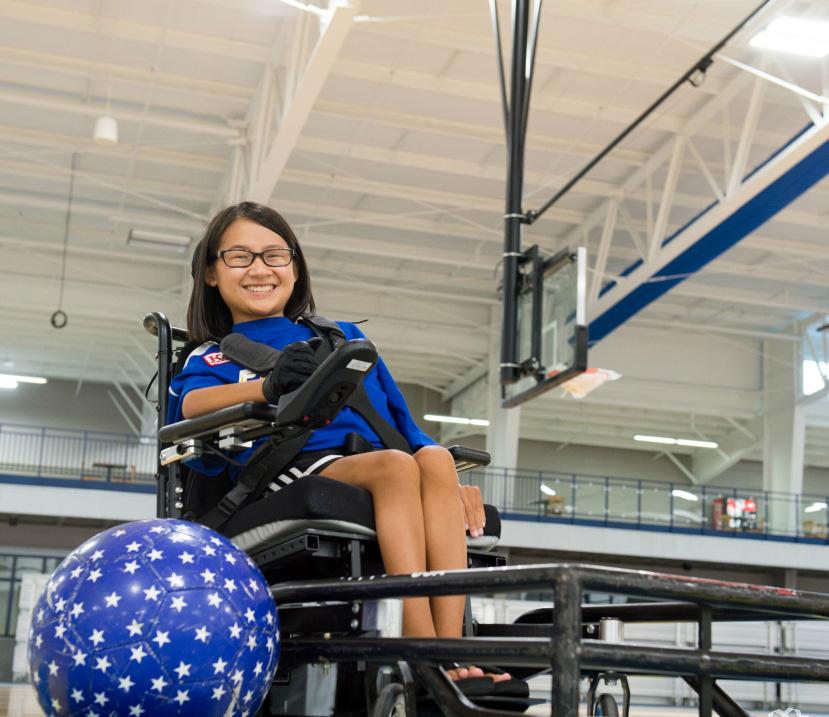 A young girl poses as she goes to play Power Soccer in her specialized wheelchair. Turnstone, Photo Provided
A young girl poses as she goes to play Power Soccer in her specialized wheelchair. Turnstone, Photo Provided
Agents of change in communities often have humble beginnings. The same can be said about Turnstone.
Its origin has roots in 1943, with it originally being known as the Allen County Society for Crippled Children, with plans to create a school for disabled children. Their plans became a reality when the school, Hanna Homestead School for children with physical disabilities, opened in 1947.
From that point on the school expanded, opening to more ages, receiving gifts and raising money to expand, relocating and adding more facilities to cater to a broader range of individuals.
In 1989, the Allen County Society for Crippled Children and Adults Inc. was officially renamed Turnstone Center for Disabled Children and Adults. The growth only continued into 2018 when they were named one of 11 Olympic training sites.
Turnstone is still moving forward to this day, encouraging its participants to reach their highest potential, whether that be in their therapy or their sports participation.
“Turnstone is a place where everyone and anyone can be involved, whether as a volunteer, as an individual with intellectual [or] developmental disabilities, or an athlete with physical differences,” photographer Nancy Myers-Scholz says.

Photography of Turnstone events, which is what Myers-Scholz is involved in, is imperative when dealing with the image and vision that the organization has. These photos show what really happens at these events.
“I really try to capture the celebrations, the teamwork, and the fun. I like to show that individuals with physical differences can fully participate in sports. I hope I capture the athletes’ determination and competitive spirit,” Myers-Scholz says.
For the participants, the vision that Turnstone has is a life-changer. The opportunities grant them something they might not have had access to previously.
“Turnstone has a one of a kind, allaccessible fitness center,” Halie Brown, former client and now administrative assistant at Turnstone says. “There’s no boundaries when it comes to our fitness center, along with our pool. Aquatic therapy is vital for my condition to keep me with the abilities that I have.”
Facilities like these aren’t available in every city across the globe. What Turnstone has here is special and they would like to continually open their doors to more and more people, Edward Whitney, director of fitness, aquatics and high performance sports, explains.
I like to show that individuals with physical differences can fully participate in sports. I hope I capture the athletes’ determination and competitive spirit.”
- Nancy Myers-Scholz, PhotographerUS Men’s National Goalball Team practices a match at Turnstone, the Goalball Center of Excellence in partnership with the United States Association of Blind Athletes. Turnstone, Photo Provided
“I hope to see membership growth in our Fitness Center,” Whitney says. “We build such close relationships with our clients on a daily basis and that has a lot of potential to grow in the future as the community becomes more aware of Turnstone and as inclusivity is prioritized in our world [and] society. We could be helping so many more individuals.”
Halie is a perfect example of the close relationships that Turnstone forms with their clients. Her experience there began at a very young age when she enrolled in their preschool program.
At Turnstone she received both physical and occupational therapy for her Cerebral Palsy.
“That was a really big blessing to my parents. As one may know, individuals with disabilities … we come with a lot of medical costs. So to be able to have
working parents and have their child be in a safe, inclusive environment and receive the therapies needed meant everything to my parents,” Halie says.
For Halie, keeping her motor abilities was imperative to her life goals, like being able to work and volunteer. Other clients’ goals, however, may be different, and Turnstone is ready and equipped to meet their needs.
“We aim to serve clients where they are at in their fitness journey, regardless of their ability, and help them reach their personalized goals,” Whitney says. “Our fitness specialists and I work every day with clients and it’s really rewarding to get to see them reach their goals as they make progress towards their independence. We truly do create possibilities!”
Not only is Halie an example of Turnstone’s abilities, but her husband
is as well. A former participant with Spina Bifida in wheelchair basketball and sled hockey, she tells of the feeling he gets when playing these sports at Turnstone.
“He said ‘What’s really neat about adaptive sports is that the playing field is even. When I get out on the ice or the basketball floor I am with the same level of abilities. We are all disabled, and we’re all using our abilities. That to me is such a strong community that only that community can understand,’” Halie says.
Opportunities like adaptive sports and the therapies that Turnstone offers are often vital to those with disabilities to help them fulfill their highest goals. With coverage of what places like Turnstone are able to provide for their communities, they are able to live out their mission of inclusivity.

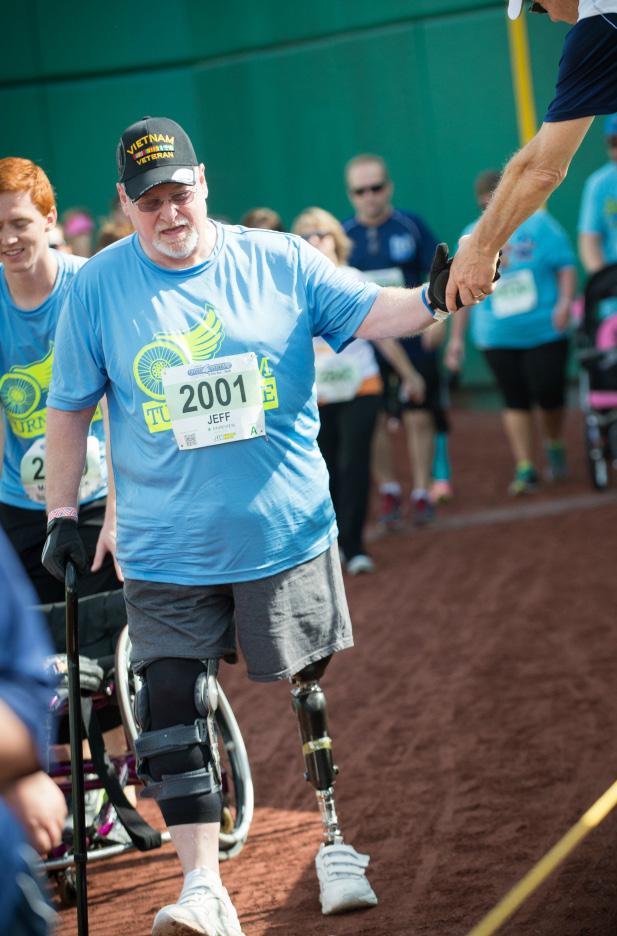
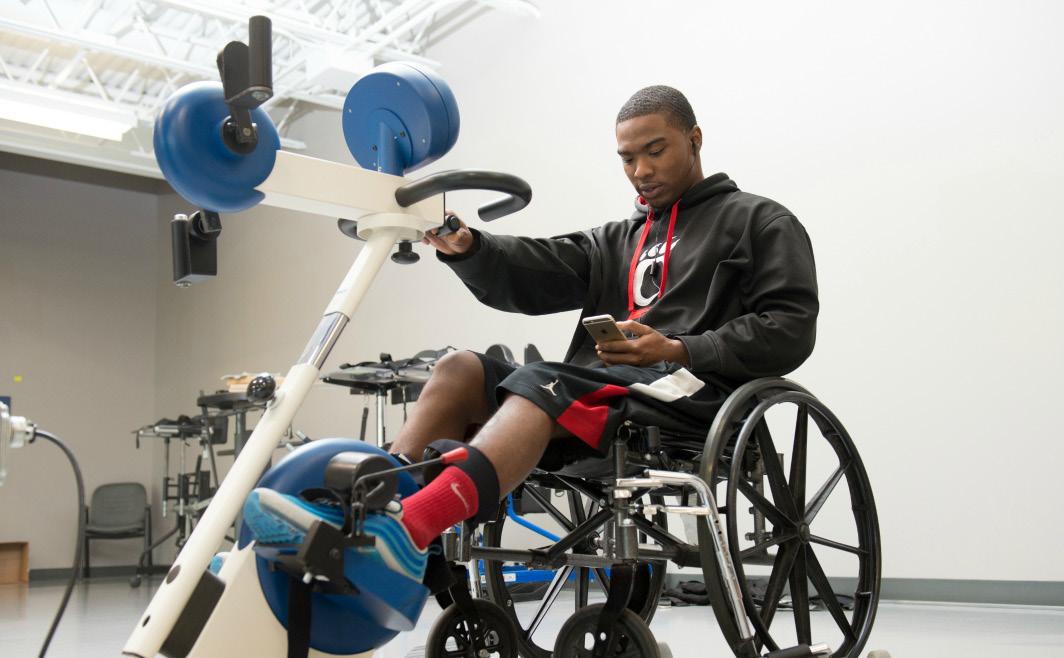
“I am proud to see how much Turnstone makes a difference in creating an inclusive environment, not only in our community but across the nation. We are one of the very few organizations in the US that provides a broad scope of services and opportunities for people with disabilities. We see the difference we make in individuals but also in the disability community,” Whitney says.
Halie’s story is just one of the many lives that Turnstone has impacted. As their name continues to grow worldwide, so does their ability to help more individuals with disabilities.
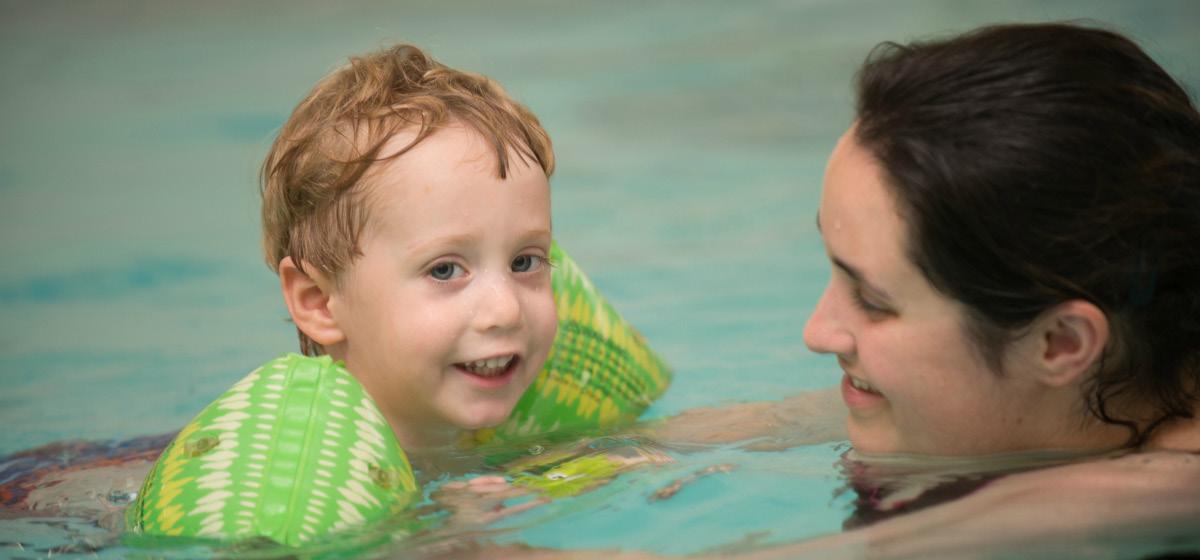
“Turnstone laid the foundation for my success,” Halie says. “If it wasn’t for Turnstone, I would not be the successful working professional that I am today and it’s not because I work for them. It’s because of what was provided to me at a very young age to learn how to use the abilities that I have.” g
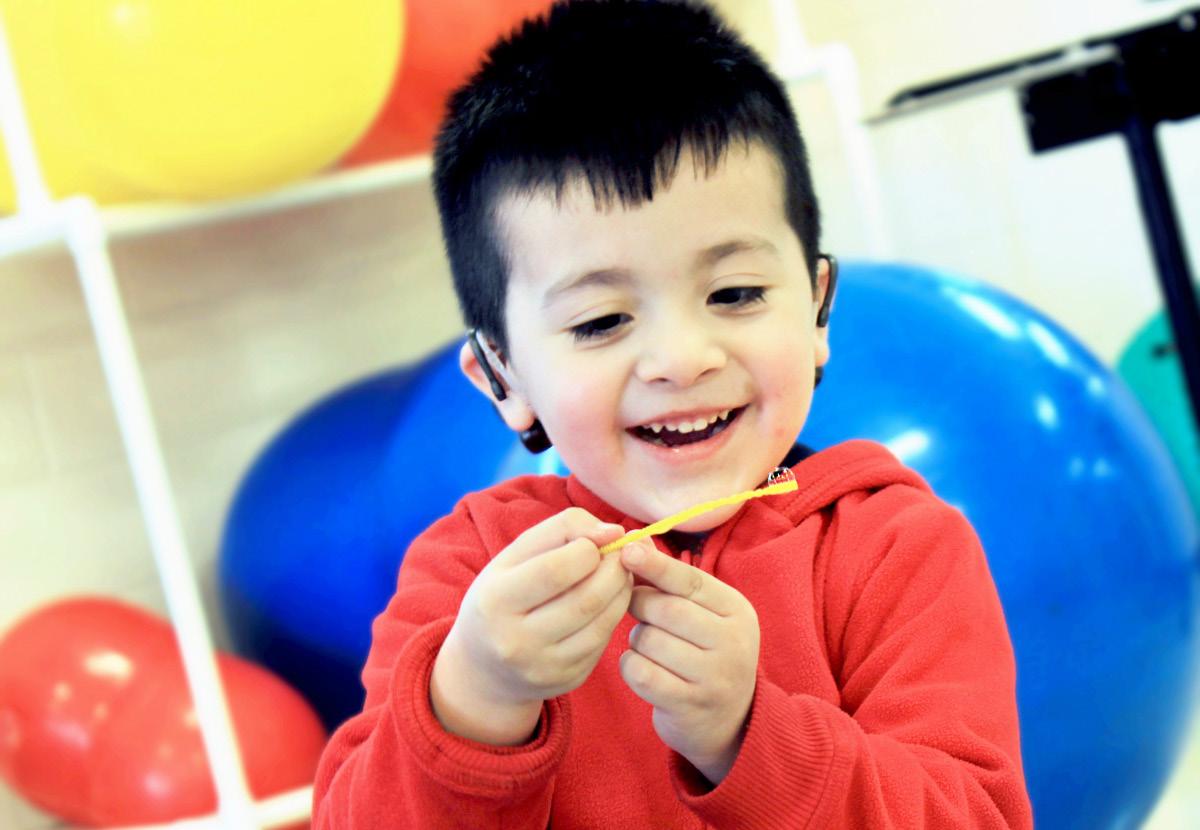
I am proud to see how much Turnstone makes a difference in creating an inclusive environment, not only in our community but across the nation.”
- Edward Whitney, Director of fitness, aquatics and high performance sports.A child plays in the Snoezelen Room, a blend of sights, sounds, textures, and motion that provide opportunities for clients to exercise choice through action. Turnstone, Photo Provided. Turnstone’s Fitness & Aquatic Center is the only exercise facility in northeast Indiana designed to include people with physical disabilities. The facility includes fully accessible fitness equipment, exercise programs, a 230-meter indoor track, and two warm-water therapeutic pools. Turnstone, Photo Provided
Beth Angella does not remember much about her early surgeries as a child, she just recalls knowing that she was different. Roughly one out of 1,600 babies are born with a cleft lip and cleft palate in the United States, according to the CDC.
A cleft lip and palate is a birth defect. During the weeks of pregnancy, the face begins to form, and tissue joins together to complete the making of a baby’s face. However, there are times when these cells don’t completely merge together, creating a cleft lip.
Apart from this, babies can also get a cleft palate, which is essentially the same process of the tissue not merging together; however, this happens with the roof of the mouth.
Babies can either have a unilateral cleft which is just one side of their face or a bilateral cleft which is both sides of their face.
With cleft patients, the struggles can come in both mental and physical forms.
Beth, who lives in the United Kingdom, has had to live through both the physical
and mental aspects of being a cleft patient all her life.
She has what is called a unilateral cleft lip and palate.
“My mother had no idea that I was going to be born with my cleft, so it was a real shock when I was born,” says Beth.
In total, Beth has undergone 10 surgeries. She had her lip repaired when she was about three months old and her palate repaired at nine months old. However, even with these initial repairs, she still had to undergo more surgeries due to complications that arose.
“I suffered with a condition called glue ear, where essentially liquid fills up behind your eardrum, and so your eardrum bursts, it’s excruciatingly painful, and it’s still one of my earliest memories,” says Beth. “To fix that I had what’s called grommets. It looks like a tiny cotton wheel, they put them in your ears, and it’s supposed to help drain the fluid.”
Glue ear is especially common in children with a cleft lip and palate, however, most children grow out of this condition at around 8 years old, according
to the National Deaf Children’s Society.
Beth had two of these grommet surgeries, but in the end, besides having to do tons of hearing tests, her hearing and eardrums never had any issues since.
The rest of her surgeries are what she calls “orthodontic work.” However, Beth does clarify that “the older you get, the [more] unique everything becomes.” When cleft lip and palate patients get older, they tend to have more of a say in what surgeries they want to get.
Because of this, Beth’s last two surgeries are what one can categorize as plastic surgery. Her ninth surgery, which was her septorhinoplasty, was her “favorite surgery.”
A septorhinoplasty is essentially the operation of the nose, either to change its appearance or to improve the breathing that happens through the nose, according to Health Direct.
“Essentially, that was the moment that my life changed because I could finally see myself clearly, and I could finally accept my cleft, and that’s the moment that I wrote my website,” says Beth.
Her 10th and final surgery was her lip reconstruction. Although Beth never worried much about her lip back then, she realized that it wasn’t until she wasn’t focusing on her nose anymore that she noticed her lip. For Beth, she did not want to adopt the same feeling about her nose, so she felt like this surgery was the best option for her.
“It was nothing like the worries that I had with my nose, it was more about I’d seen it and I thought well that’s sort of a bit of a visual reminder of my cleft and I didn’t want to go back,” says Beth.
Before all of this, Beth recalls several instances from when she was younger, specifically when she was 14 years old, where people would make her feel insecure about her cleft, causing even more mental turmoil.
“I had a moment where I was in history class and the new film ‘Avatar’ had just come out, and I put my hand up … and these not very nice children at the back of the class would go ‘Avatar’ every time I put my hand up,” says Beth.
Nonetheless, Beth, six years after this instance happened, recalls a moment
when she thought back to this occasion when she suddenly “felt this sort of release” and actually “[felt] sorry” for those children.
After Beth’s nose surgery, she felt like it was necessary to write down everything that she had gone through.
“Reflecting on my teenagehood, my own self-beliefs about hating myself because of my cleft, all of that, basically I just had to start writing it down,” says Beth.
Through her blog, Beth has seen “the good power of social media.” She also specifies that it’s important for others to know just how unique her journey is. Other cleft lip patients will not go through the same thing, but Beth wants to be an example for the small percentage that might.
“I was desperate to see that at 15, I was desperate to hear not about a parent talking about their child, but about another person with cleft themselves, who knew how unfair it was, who knew how difficult it was, who knew what it felt like to be an ‘other’... but then ultimately it was going to be okay,” says Beth.
Because of her blog, Beth continues to help parents and children like Willow Lund who are going through the same experience.
Willow is a 21-month-old toddler who has a unilateral cleft lip and palate. So far Willow has gone through two surgeries. However, it is estimated that, through the course of her life, she will have to go through seven or eight more.

Children with a cleft lip and palate may not grow up having speech issues. However, some are still given a speech pathologist to work with them to avoid issues regarding articulation of words, according to kidshealth.org.
Her mother Alyssa Lund, a former special education teacher, says, “When I heard that Willow was going to have a cleft, I wanted to make sure that she could communicate her basic needs at least as a baby so I started teaching her [sign language] really young.”
As of now, Willow does not have any special needs in terms of speech, however for her mom, it was important for her to make sure that Willow could communicate with her so that no behavioral issues would arise.
You can own your cleft as a part of your identity but it doesn’t need to define you.”
- Beth Angella, Cleft patient and bloggerWhen Willow was born she had a 19-day-stay in the NICU and had to have a feeding tube because she wasn’t eating as much as they would’ve liked. It was mainly because she was born a month early. And then it became about her figuring out how to eat with her cleft. Photo provided, Alyssa Lund
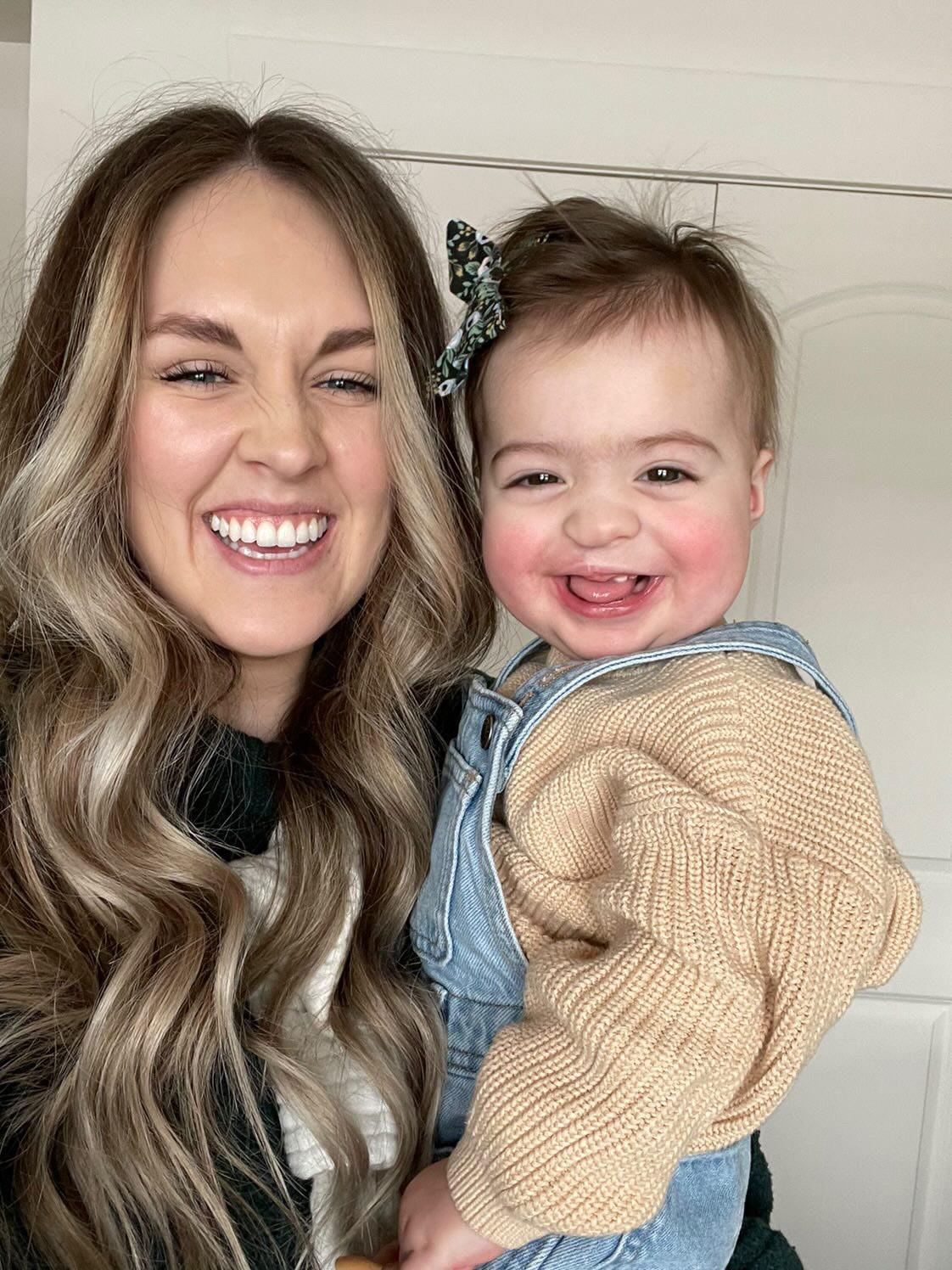



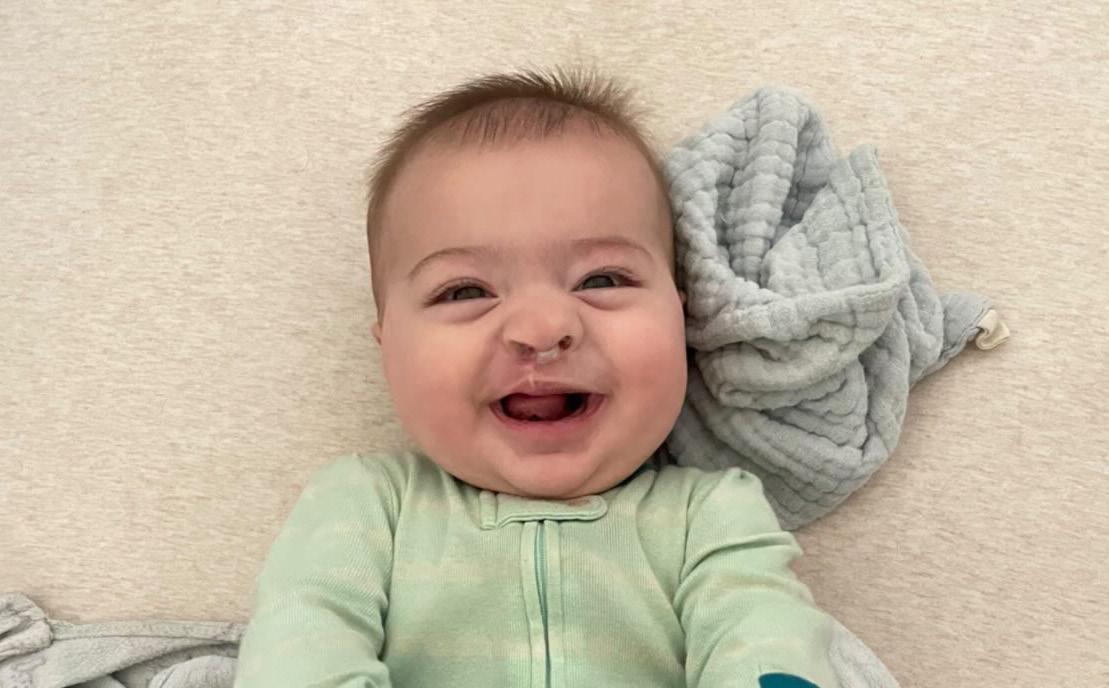
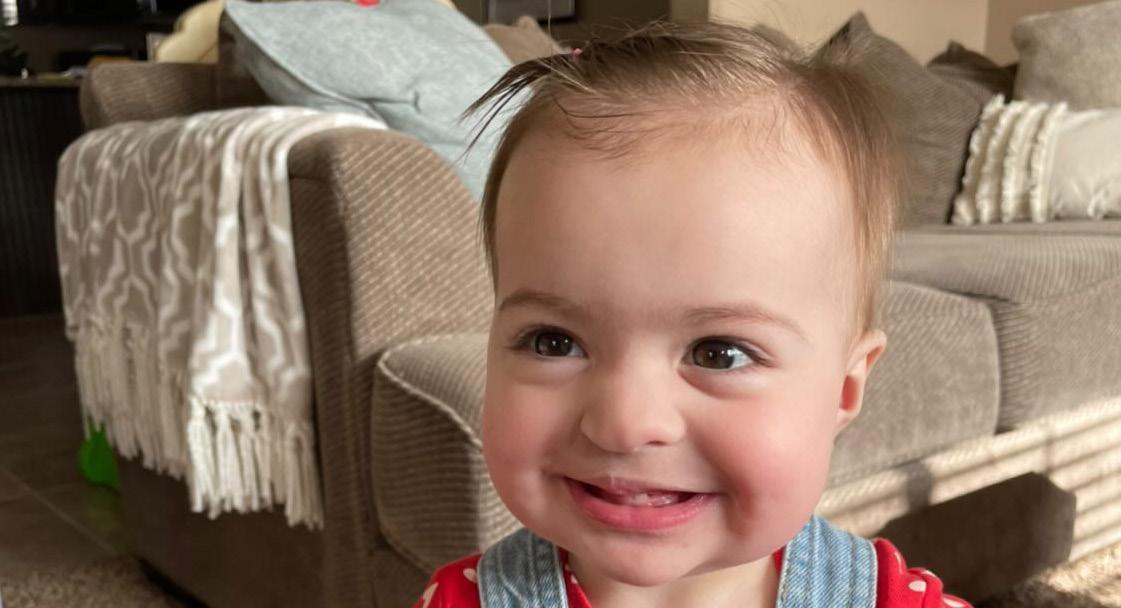
The most prominent issue that arrived with Willow’s cleft was being able to eat. Alyssa recalls how Willow had to be fed in a specific way so that the milk she was drinking would drain away from her cleft so that it wouldn’t go up into her nose. Apart from this, as Willow started getting older and feeding on solid foods, her soft palate was still open, so whenever she would eat and sneeze or spit at the same time, it would come up through her nose, causing messy disasters for her.
Through all of this, Alyssa says, “It was just not your typical newborn experience.” She remembers the times when she had to unintentionally cause her baby pain, like massaging her scar after her surgery and even inserting nose stents to make sure that Willow was breathing properly.
As a first-time mom with this experience, Alyssa knew it was crucial to create an Instagram account to document their journey.
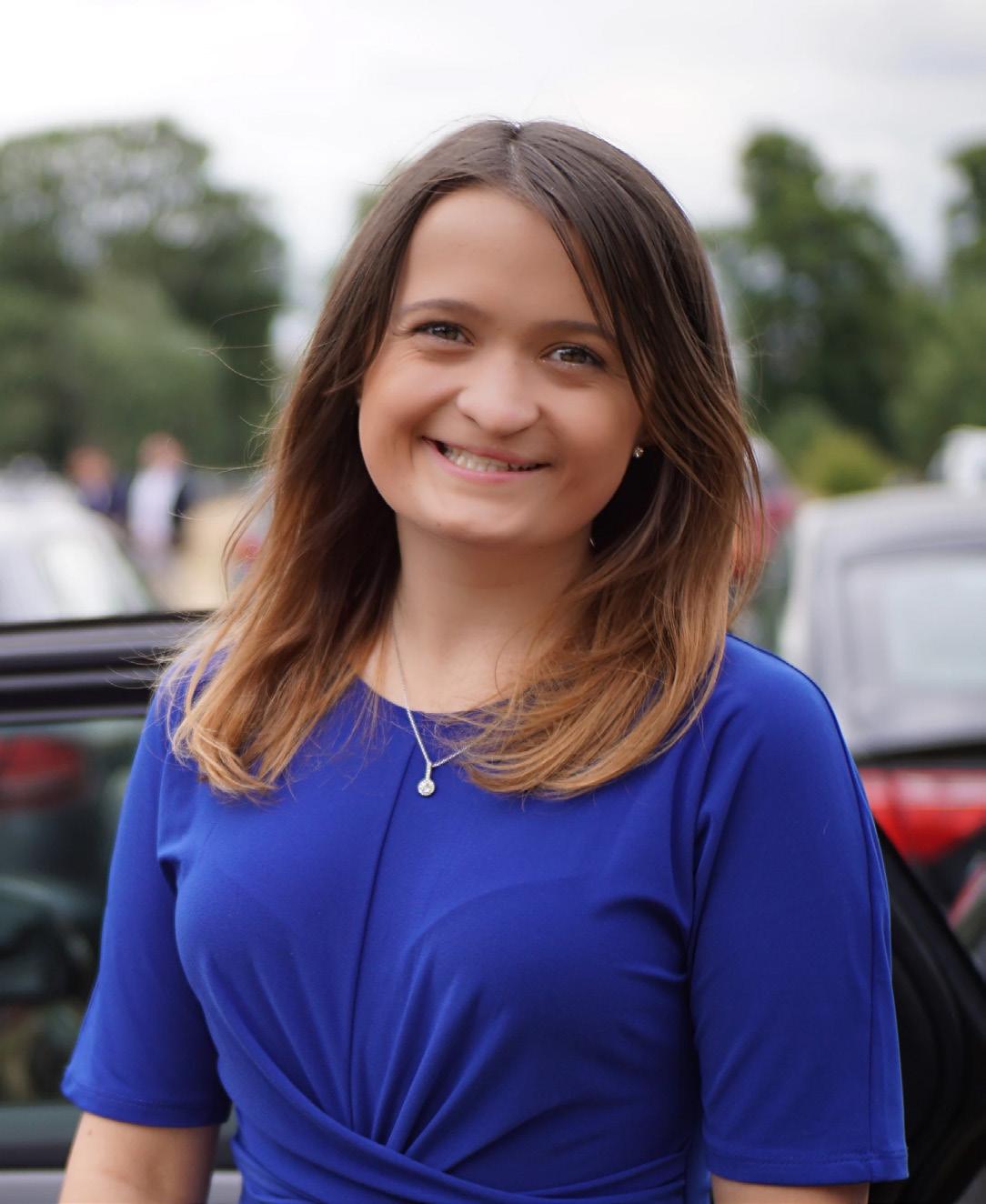
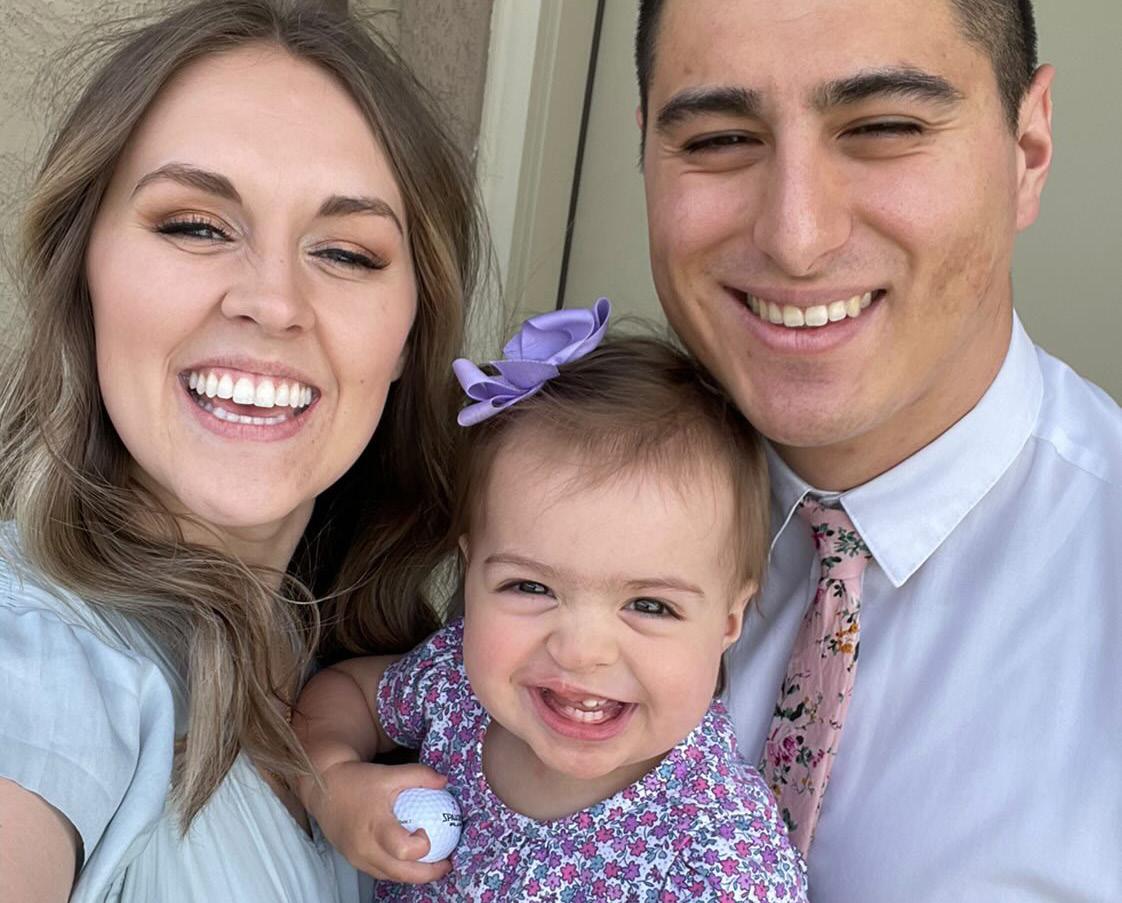
“I thought if I could create an account and help just one mom out there, to see what it’s like to know that it’s going to be okay. To know that yes, it is hard but that I’m there to help you, to just have that support and have someone that knows exactly what they’re going through,” says Alyssa.
Through Instagram, Alyssa is making sure to teach Willow about self-love as she continues to get older, assuring her that she is special because of her cleft.
“You are so special and you are so unique, you have something that a lot of people don’t, you have experiences that a lot of people aren’t going to go through. You have more empathy and sympathy for kids who have to go through surgery, for kids who spend time in hospitals…although it’s so hard, it’s such a blessing too.” g

You are so special and you are so unique, you have something that a lot of people don’t, you have experiences that a lot of people aren’t going to go through.”
- Alyssa Lund, MotherBeth, twenty-one years old, after jaw, nose, and lip surgery. Beth Angella, Photo Provided Willow at 21 months old. Alyssa Lund, Photo Provided
Senior drawing major Misty Fox sits in her studio surrounded by pieces she created that explore textures and inspirations from her life. Morgan Hagerty, Ball Bearings.
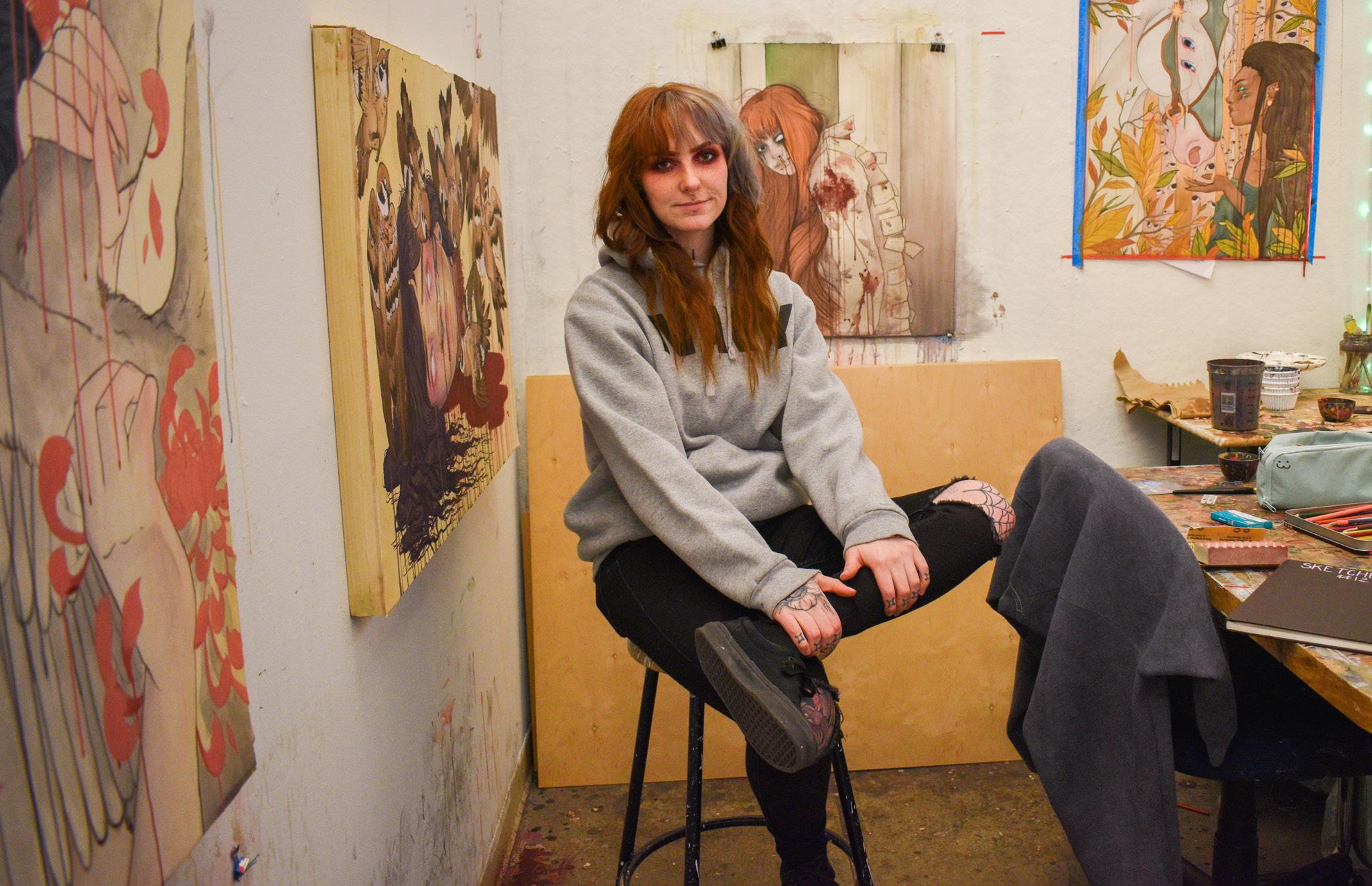

Senior studio art major Emile Giffin works on the next part of their series about coming of age and its uncomfortable experiences with color and animals. Morgan Hagerty, Ball Bearings.
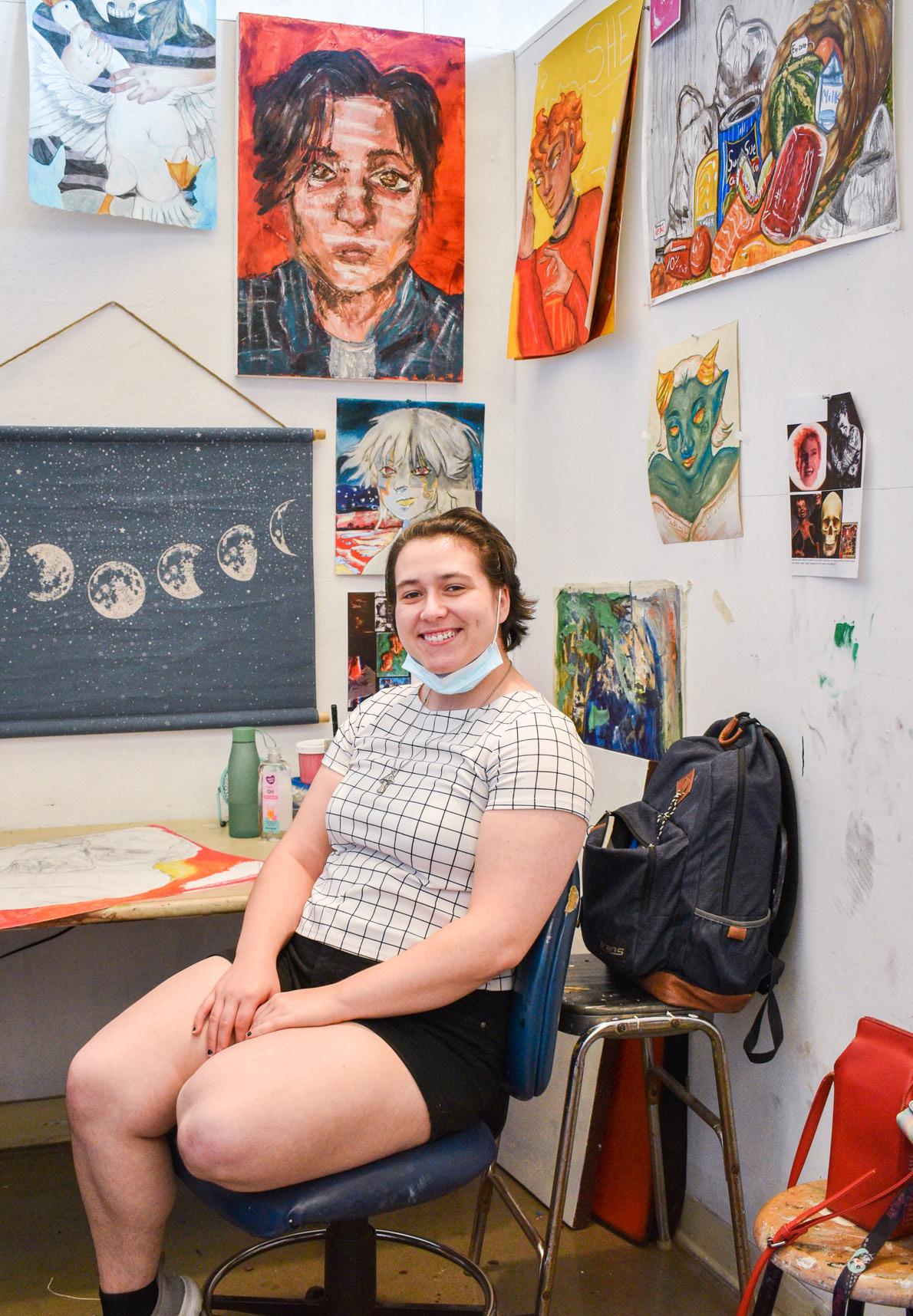

 By Kami Geron
By Kami Geron
It’s often called a gift, an eye, a gut feeling. To be artistic is a loaded way of creating new, transformational pieces that change the world — even when you’re still discovering yours.
I’ve been an “artist” ever since I could remember. My imagination took me to worlds far into the future or far away from where I was. This exploration led to cheesy art sets for birthdays and numerous bins of artwork that my mom would keep.
It was truly scary to think I had to give up on that part of myself. During school, as I continued my classes in art, my counselors would direct me towards my other passion: writing. The duality of writing and designing seemed like it would end at high school; maybe art was just a hobby…
I mean how could I think that I could make it as an artist? Most famous artists didn’t get famous until after they had passed away, and in the world of social media how can you even be original anymore?
I just didn’t think I was special enough, so art had to take a backseat because the real world doesn’t care about love: it cares about bills and taxes.
To sit here and write this as a graduating senior with degrees in art and journalism seems like the imaginationland I created as a kid. It’s the loaded question I still avoid – “what are you going to do after college?” The reality is I don’t know, but I finally have leaned into not knowing. I’m no longer scared to panic and find a job or an answer for every stranger I meet. Instead, I’ve taken the time to fall back in love with art, and I was able to meet people along the way that
never let me feel alone in our new world we discover.
In our studio class, we are artists and a community. We all embrace being an artist and being artistic. We are creative, we are problem solvers, and we all have this unspoken understanding between one another. Some of us have just met, some of us have known each other from our first year on campus, but we all share the artistic sense.
The sense undoubtedly affects our works: they are visual pieces that evoke different emotions and experiences from each viewer. But no matter what music we choose to listen to, what paints to mix, what fixatives to spray, and what angles to work we create art, it’s the unexplainable phenomena that has made art so historical in human lives and will continue to shape the world — one person at a time.
Senior studio art major Riley Sims spills and moves paint on her canvas until it feels right-using her gut feeling and artist senses. Morgan Hagerty, Ball Bearings.
Senior studio art major Hannah Farber works with recylclable materials to communicate the imporance of sustainability in the world. Morgan Hagerty, Ball Bearings.


Graduating senior drawing major Bec Ember uses their love of animation and fantasy to create works that will create emotional worlds for the viewer to experience. Morgan Hagerty, Ball Bearings.
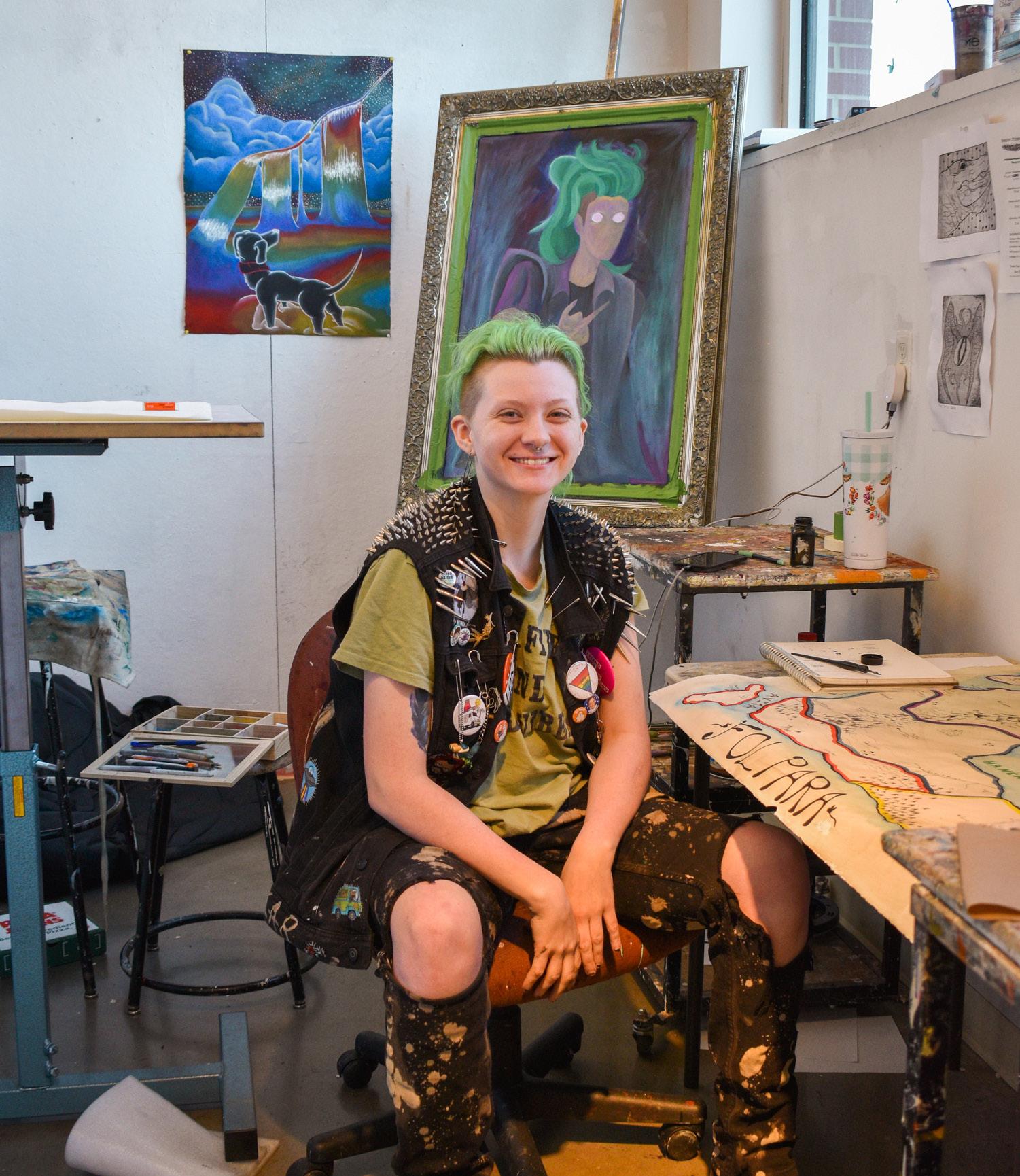

Graduating senior drawing major Allison Smiley adds a new medium to her paints to play with textures and visual illusions in her artworks. Morgan Hagerty, Ball Bearings.

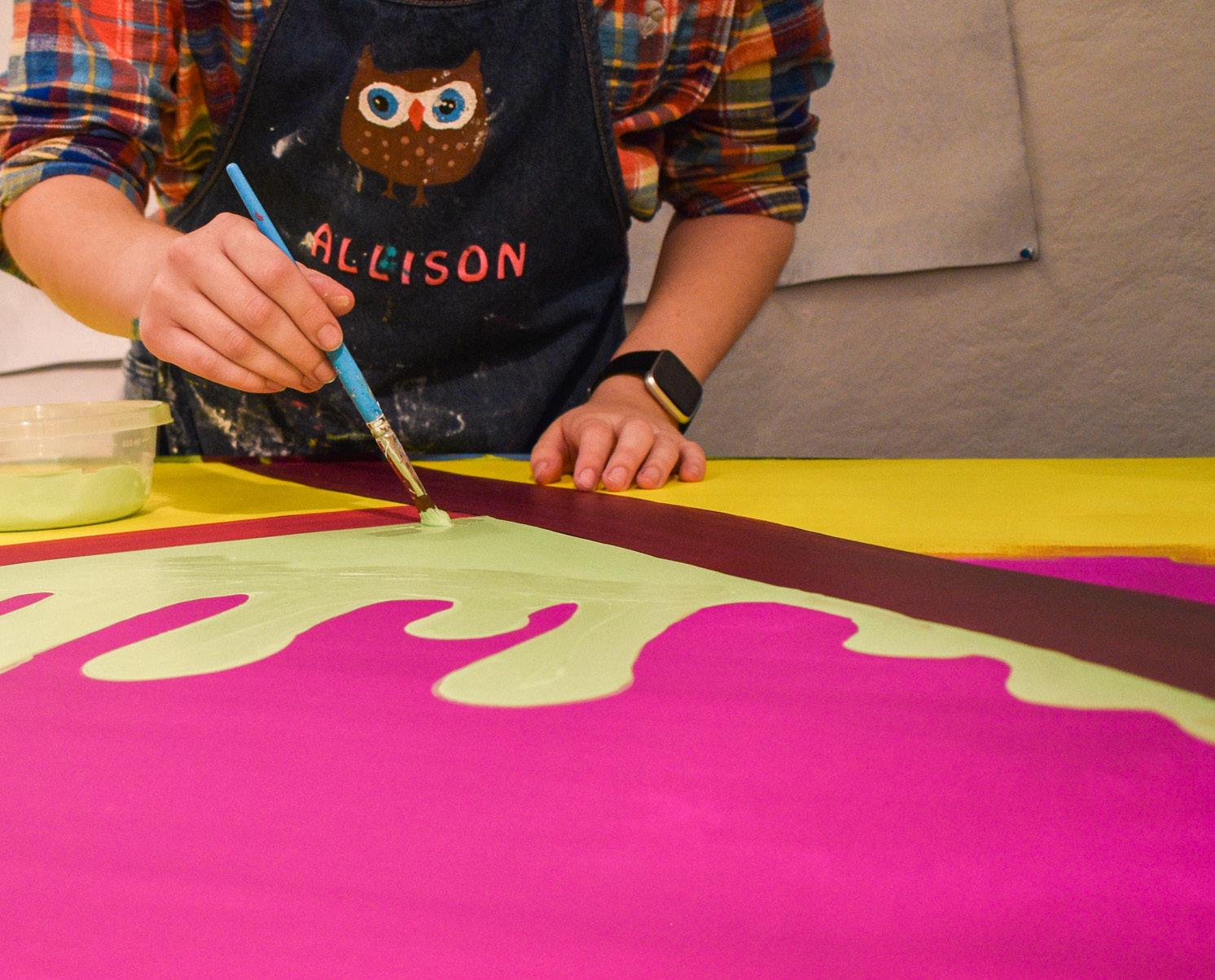

Senior drawing major Skye Day uses non-typical color palettes to illustrate the Boots Theory in her works. Morgan Hagerty, Ball Bearings.
Graduating
senior drawing major Dallyss Hamrick changes the experience of mundane house items by painting from memory on custom wood cutouts she creates. Morgan Hagerty, Ball Bearings.The effect of alcohol addiction on two men’s lives.
Landon Boyd knew he would die in Alabama. He was born to a mother who needed alcohol to live, a father who left before he had a name and a community that drank no matter the occasion.
But despite where he came from, he performed well in school and played football like it was something he was born to do. It wasn’t until an injury took him out of the game, that apathy set in and he turned his sights to the bottom of a bottle.
“I started experimenting with alcohol in high school,” Landon says. “Not everyday, but I would drink at parties and get togethers. One of my first warning signs was, whenever we did drink, I would always be the only one that never passed out. I would always be the one to drink the most and still be coherent.”
That’s how he found himself graduating high school on a tidal wave of tequila. And since he had decided college wasn’t worth the stress years before he had even held a beer, he went straight into the army to escape his tumultuous home life.
It was soon enough after leaving high school that Landon’s life began to look much like how the story goes: At 19 years old, he met a woman, settled down, and had a baby girl with a smile just like his. It was happily ever after, but there was just one caveat.
He needed to drink in order to stomach it all.
“I couldn’t stay sober for anything, because when I came home I didn’t want to feel anything,” Landon says. “It wasn’t that I enjoyed the drinking, it wasn’t fun. It was functioning. It was the only way I could face my reality. It was to the point that I tried to feel nothing, and I succeeded.”
For most, 10 years is a long time to watch life pass by, but for Landon, the speed at which time moved was slowed to a snail’s pace. Name whatever comes to mind — vodka, bourbon, tequila, beer — if it had an alcohol content, Landon had at least two in hand.
That’s how, come the year that would have marked the 10th anniversary of Landon’s marriage, two things came to pass simultaneously: one, his relationship would end in a hailstorm of long repressed emotions; two, his drinking would send him into a life-changing spiral.
According to the Alcohol Rehab Guide, “People with high stress, anxiety, depression and other mental health conditions are more vulnerable to developing alcoholism. In these types of circumstances, alcohol is often used to suppress feelings and relieve the symptoms of psychological disorders.”
Following his stint in the military, Landon suffered from depression, which culminated in him drinking over a gallon of vodka a day. His substance abuse disorder became incredibly dire as a result, to the point he kept a bottle under his pillow at night just so he could take three or four hard chugs of the stuff in order to get out of bed. It was at this point he was diagnosed with cirrhosis, or scarring, of the liver.
“I was dying, and I didn’t want to die,” Landon says. “But I was slowly committing suicide. I was puking blood, I was shaking constantly, I couldn’t see and I couldn’t hardly remember things. My brain was always in a fog.”
The haze that Landon lived in is a common symptom of alcoholism. This loss of reality and connection to the symptoms is increasingly exacerbated the longer an individual drinks.
“As the body’s control center, the impairing effects of alcohol quickly impede the normal function of areas all over the body,” the Alcohol Rehab Guide says. “Short-term symptoms indicating reduced brain function include difficulty walking, blurred vision, slowed reaction time, and compromised memory. Heavy drinking and binge drinking can result in permanent damage to the brain and nervous system.”
Unfortunately for Landon, this blur that accompanied alcohol abuse was only thickened by his growing penchant for drugs, including methamphetamines and cocaine.
Knowing that death was an imminent threat if he stayed in Alabama, Landon made a choice. He took what he could and left town to head north where he heard the rehab programs were reliable and alcohol was therefore less compelling. Over the next couple of years, he slowly traveled — exclusively on foot — from northern Alabama to Indianapolis.
During this time, Landon took cover wherever he could find it. Salvation Army, tunnels under bridges, bus stations and VA hospitals all served as temporary shelters.
It was only upon his eventual arrival in the Circle City that he was finally able to discover a kindness and safety unlike any other he had encountered.
“Recovery is painful, physically,” Landon says. “But once I got here, I came across places that blew my mind with how much they actually genuinely care. They don’t call you by your last name here, they call you nicknames. They’re friends with you on Facebook, they’ll come knock on your door and check on you.”
One of those friends that Landon met in Indiana was Kevin Shafer.
Kevin, began drinking at 10 years old, and has been sober for 13 years now. Currently, he serves as a District Committee Member (D.C.M.) and Chairman for Alcoholics Anonymous (A.A.).
According to A.A., “The D.C.M. is a key link in ensuring that all the A.A. groups are aware of the importance of their total participation in local, district, area and world services.” In addition to this, D.C.M.s are elected officials who serve for two-year periods of time.
As a recovered drug and alcohol abuser himself, Kevin knew the path to sobriety was littered with meth-filled potholes and shattered bottles of vodka. Seeing that Landon needed help navigating the road, he extended a hand.
- Landon Boyd, A.A. member
“[Landon] dated my niece. They broke up on pretty good terms, they just didn’t want to be together anymore, and he had no place to go, so my niece asked me if he could come and stay with me for a couple of weeks, ” Kevin says. “We ended up forming a pretty good friendship, and now it’s more of a father-son relationship, and he looked at me as a good mentor.”
It was during this initial period when Landon stayed with him that Kevin found out he was continuing to abuse drugs and alcohol.
“He was still drinking and doing some other substances at that time … and he was hiding them from me,” Kevin says. “One day, I told him I was going to McDonald’s and I came back early and he hadn’t heard me come in the door and I caught him putting away the methamphetamine pipe into his dresser.”
Furious, Kevin asked him to leave so that Landon’s habits would not compromise his sobriety. Landon agreed, and left for a period of nine months until his health issues once again rendered him homeless.
That’s how he and Kevin were ultimately able to reconcile their differences.
“What keeps me sober now is remembering how bad I was,” Landon says. “How sick I was, how painful it was. How many people I hurt, and how bad I hurt myself. And that keeps me from ever wanting to go back.”
Throughout the course of his time in the Indianapolis program, Landon was planning to move. He eventually settled on Muncie as his destination.
As of publication, Landon Boyd is 36 years old and has maintained his sobriety for approximately 18 months. Going forward, he eventually plans to return to school to pursue a career as a rehabilitation specialist and eventually move to the Pacific Northwest.
Though Landon is looking forward to fulfilling these lofty dreams, he says he isn’t quite ready to leave his newfound family, sobriety and community. This is why – for now at least – Landon is content to call Muncie his unexpected home.
If you or a loved one is currently struggling with alcohol/drug abuse in Delaware County, please reach out to Shaffer for literature and guidance at (765)212-8352. You can also call the Substance Abuse and Mental Health Services national helpline at 1-800-662-4357. g
What keeps me sober now is remembering how bad I was. How sick I was, how painful it was. How many people I hurt, and how bad I hurt myself.”
- Landon Boyd, A.A. Member
Blurred vision. The feeling of being trapped. A heavy chest. The senses are remembering and so is the body. This is post traumatic stress disorder (PTSD).
When someone with PTSD is experiencing a panic attack or trigger, all of these fight or flight responses can occur, according to Brittany Snyder, licensed mental health counselor and trauma specialist.
Snyder gained experience in working with survivors that have trauma through her graduate school program and has worked in the profession for 10 years since graduating.
Although Snyder currently holds a full-time position as a staff counselor at Indiana University Purdue University of Indianapolis (IUPUI), last year she opened her own private practice, Aura Counseling and Wellness.
Snyder meets virtually with clients from areas all over Indiana. Even though it’s much different than meeting with clients in person, she’s still able to tell so much from a person’s screen.
“You can still do very good work virtually,” Snyder says. “You can still really read emotion over a screen. Backgrounds tell us a lot, facial expressions, tense shoulders, noticing if they’re jittery, eye contact with the camera and changes in voice.”
Although there are a lot of different trauma practices in the profession, Snyder uses body emotion awareness. Body emotion awareness is the act of getting a survivor to connect their emotions to what they’re feeling in their body.
Emotions can show up in the body in many different ways, and sometimes certain areas of the body are associated with certain feelings, says Snyder. Most commonly, shame can be felt in the stomach or gut. Chronic stress can be found in the stomach, stress and anxiety can be felt in the chest and sadness can be felt in the eyes, nose or overall facial area.
“PTSD is when somebody’s basic trauma responses are activated after experiencing something threatening or perceived threat, but they get stuck in their survival response,” says Snyder.
The “survival responses” are most commonly known as fight, flight, freeze, and fawn. Someone with PTSD gets stuck in one of those survival responses — their brain doesn’t go to recovery mode the way it needs to, says Snyder.
People with PTSD find that their somatic nervous system is activated a lot, and the work Snyder does involves trying to get their nervous system to be parasympathetic, or the proper pathway to recovery mode.
According to the Queensland Institute, the somatic nervous system, otherwise known as the voluntary nervous system,
contains afferent and sensory neurons that inform the central nervous system about the five senses and voluntary movements of the body. According to the Cleveland Clinic, the parasympathetic nervous system is a “network of nerves that relax your body after periods of stress or danger.”
Although PTSD might commonly be associated with veterans and fireworks, Snyder hopes the culture has a shift around the idea of trauma.
“It takes a collective paradigm shift,” says Snyder. “It’s important to challenge these wrong biases. We just need to talk about it. That’s the key.”
Although a person experiencing PTSD might feel like something is wrong with them, it’s their brains and bodies adapting to the threat, says Snyder. She likes to normalize adaptation with her clients.
“You’re not broken,” says Snyder. “This is what the adaptation would be. But we can change it with help.”
Although clients may see Snyder and exercise a talk-based therapy, she noted three main techniques that are used for clients experiencing PTSD: Eye Movement Desensitization and Reprocessing, Brain Spotting and Somatic Experiencing.
Even though talk therapy, EMDR, Brain Spotting and Somatic Experiencing are all therapy techniques for PTSD, there’s another technique that might be more appealing to a canine-loving client.
Although society calls them a “man’s best friend” because of their affection and personalities, they should be given the title due to their similar brain activity to their owners.
“You’re not broken...This is what the adaptation would be. But we can change it, with help.”
- Brittany Snyder, Owner of Aura Counseling and Wellness
When humans are experiencing a panic attack or a stimulus that reminds them of a traumatic event, a “neuro superhighway” forms that leads to the back part of their brain, says Lydia Wood, CEO of the Freedom K9 Project.
Every time a person experiences a panic attack or trigger, the electricity in their brain travels down the neuro superhighway and becomes entrenched with activity, and all that electricity travels down to the back part of their brain - a part of their brain they don’t have access to during a panic attack. The same neuro superhighway forms in dogs, but instead of a panic attack, it’s called barrier aggression.
When a dog furiously barks at another dog while restrained on a leash, that is an example of barrier aggression.
Dogs’ mechanisms and “survival techniques” are the same as humans, says Lydia. Their brain also creates a neuro superhighway and the information travels down to the back part of their brain.
“It’s not a matter of disobedience,” says Lydia. “When we’re working with dogs, we utilize this and step in before the neurotransmitters become overwhelming. We use motivation to rewire the neuro-pathways so when the dog sees another dog the electricity is being pushed elsewhere. Then we can take the electricity out and let it just flow where we want it to.”
In the past, Lydia found herself visiting a church in Atlanta that presented about survivors of human trafficking. She had a strange feeling about the message of the presentation after listening to it.
She felt that there had to be an organization that had service dogs solely for survivors with PTSD, but with intense internet search, she had no luck.
According to Lydia, the average cost of paying for or fundraising for a service dog for a PTSD survivor can range anywhere from $40,000 to $60,000.
Lydia has always classified herself as a “dog person” and immediately got certified as a dog trainer when she was 18.
After finding out that there were no organizations solely for PTSD survivors, she “fell down the rabbithole,” she says. She completed an internship program with veterans that allowed her to take dogs with her to restaurants, on vacation and simply in her home.
Five years later, Lydia is the CEO of the Freedom K9 Project and she runs her own dog training business, Naptown K9.
Because the Freedom K9 Project is a non-profit business, they are constantly restructuring their program and working to help survivors all around the world. Lydia is currently working with dog trainers in different states to expand the project through the nation.
The training process for these service dogs generally takes between one to two years, says Lydia. The organization gets information from the survivor and the survivor’s therapist to try and teach the dog to see early signs of panic.
Although signs of panic vary for each survivor, some include freezing, changes in breath, cuticle picking, hyperventilating and blinking quickly.
“It’s kind of a game at first,” says Lydia. “We have to be creative with it. Often, the dog is so tuned in that they start recognizing the psychological changes that happen before, like your heart beat starts changing or labored breathing.”
The Freedom K9 Project is actively training Genesis and Sam to be service dogs for PTSD survivors.
Generally, Lydia has reached out to rescue organizations to find out when they get a new litter of puppies in, which is where Sam came from. Sam is a mix between a pitbull, border collie and golden retriever, and his black and white spots mirror a cow, says Lydia.
“He’s like a fun little cocktail,” says Lydia.
Genesis, a black Labrador, was donated to the Freedom K9 project from a purpose breeder in Montana. Although Lydia can’t remember the specific family tree, Genesis could be the seventh generation in her canine family to be service dog bred. g
A technique where the survivor and therapist talk about three time periods: past, present and future while undergoing an 8-step process that includes bilateral simulation, which is “used to activate and integrate information from the brain’s two hemispheres.”
This technique “locates points in the client’s visual field that help to access unprocessed trauma in the subcortical brain.” This process also uses BioLateral sounds, or an alternative to bilateral simulation as discussed in the therapy technique above.
Created by “gently guiding clients to develop increasing tolerance for difficult bodily sensations and suppressed emotions, building their capacity for containment and resilience,” according to the Ergos Institute.
Every baby is different. Some babies spend their first days in small incubators, not able to be taken home. Premature babies are often not strong enough to go home at their time of birth. Some parents are not able to hold their baby, and some only have the opportunity to do so for small moments in the day. So, hospitals take steps to make sure these babies are getting the touch they need to develop properly.
At Ball Memorial Hospital, there is a Baby Cuddler Program with volunteers like Kay Stickle. She has been volunteering at the hospital for 36 years and spent 20 of those years in the neonatal intensive care unit (NICU).
Before COVID-19, Kay had been working in the emergency room and NICU at the same time, having to set up her schedule so she would have a week in between the two departments.
“I would know if I had caught anything from emergency before I went to NICU,” says Kay.
Anyone working or visiting a NICU should not come in if they are coming down with sickness or not feeling well. Most cold viruses are caused by direct contact and are difficult for premature babies to fight off.
“If I had come in contact with some communicable disease or germ I would not carry it to NICU, because our babies are so fragile, and our families are fragile,” Kay says.
According to the New York Dept. of Health, babies born between weeks 23 and 28 are considered extremely preterm, as a full term will last 40 weeks. The survival rate of a 24 week old preemie is between 60 and 70 percent while a 28 week old preemie has about an 80 to 90 percent rate of survival, the University of Utah reports.
Chelsea Keller, a nurse practitioner at Meridian Women’s Health who worked in a labor and delivery unit for about seven years, says “When you have so many synapses, so many neurons firing in the brain, every single moment, every single second is an opportunity for learning and development in newborns.”
Occasionally when a baby comes in that has sensory sensitivity and the nervous system has not developed, Kay says, “We simply put our hands over them… and they will quiet down because they can feel the warmth of our hands and we will whisper softly to them”.
When babies get a little bigger and are
able to be touched, but not held, what’s called hand hugs are implemented. This is done by placing one hand on the baby’s head and the other on the stomach or around feet, according to Mach of Dimes.
In a study done by Paediatr Child Health, it was proven that on average, babies who participated in a cuddler program spent 6.36 less days in the NICU. This was tested on neonatal abstinence syndrome, which is when a baby is exposed to opioids for a period of time in the womb.
NICU’s also care for babies that are born with alcohol or drug dependency. Kay says, “they have to go through the withdrawal, just like anyone else.”
Neonatal abstinence syndrome can develop in babies if the mother continues to use the drug until about a week before giving birth, the National Library of Medicine reports.
Keller explains, “One of the major symptoms we see in neonatal abstinence syndrome is a heightened moro reflex.”
Baby
and medical experts discuss the benefits of physical contact with premature babies.
We simply put our hands over them... and they will quiet down because they can feel the warmth of our hands and we will whisper softly to them.”
- Kay Stickle, Baby cuddler
Moro reflexes are tested when a baby is born by lifting the baby’s head gently and releasing the head quickly. The baby should have a startled look and their arms moved sideways with palms facing up. With Neonatal Abstinence Syndrome, they will have a hyperactive moro where the baby’s arms will stay up in the air lasting about three to four seconds, according to North Carolina Pregnancy & Opioid Exposure Project.
Babies going through withdrawals have heightened senses and cuddling has a similar effect to calm them, “as a weighted blanket for somebody who has some sensory issues,” says Keller.
The volunteer cuddlers have many responsibilities outside of cuddling,
including changing bedding, changing diapers, feeding, making signs, and stocking the rooms with supplies, says Kay.
Cuddlers hold the babies when feeding them through a nasal gastric feeding tube to, “connect food and love and all those things together for them,” says Kay.
Babies will often cuddle and mold themselves to the holder, in order to comfort themselves. Babies will attempt to get as much physical contact as they can, reported by The National Library of Medicine.
Nurses are given ratios to how many babies they can take care of at one time and baby cuddlers are able to make up for the difference, says Kay.
NICU nurses and cuddlers have Kangaroo Care Slings to help them hold babies while attending to other babies on the floor. Keller says, “baby cuddlers are just absolutely essential in providing this kangaroo care in place of what a parent or guardian can provide for their babies.”
Touch is imperative for all babies, especially NICU babies for a number of reasons. Babies spend nine months in a warm, dark environment.
“Any kind of human touch human interaction really sets these babies off for success,” says Keller. g
When you have so many synapses, so many neurons firing in the brain, every single moment, every single second is an opportunity for learning and development in newborns.”
- Chelsea Keller, Nurse practitionerIllustration by Mikah Mevis
There are different types of color blindness. The three main categories of color blindness are red-green, blue-yellow, and complete color blindness, also known as monochromacy.


Red-green color blindness is the most common color blindness and splits into four different forms; deuteranomaly, protanomaly, protanopia, and deuteranopia.

the person affected unable to differentiate between both red and green.
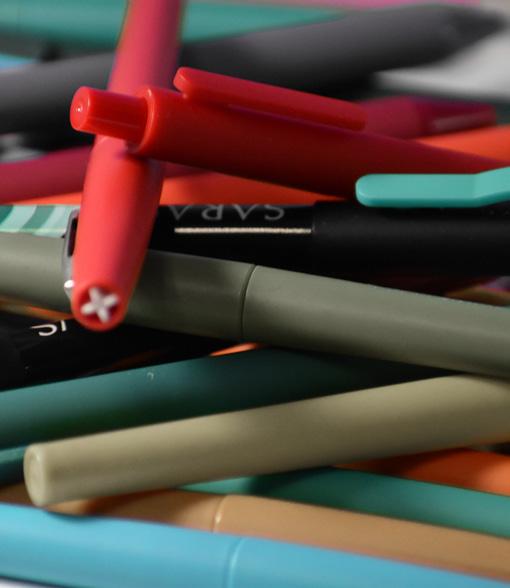
 By Grace Adcock
By Grace Adcock
The most common type is deuteranomaly, which turns shades of green more toward the red side of the color spectrum. Protanomaly is the opposite of the first type. This type turns the color red into green. Both protanopia and deuteranopia make

Blue-yellow color blindness, the least common of all, splits into two different forms; tritanomaly and tritanopia. Tritanomaly makes it hard for the person affected to differentiate between green and blue as well as red and yellow. Tritanopia makes differentiation of green and blue, pink and yellow, and red and purple difficult.

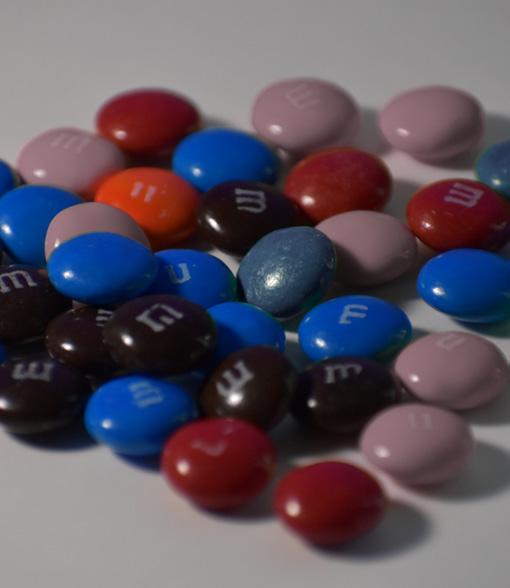
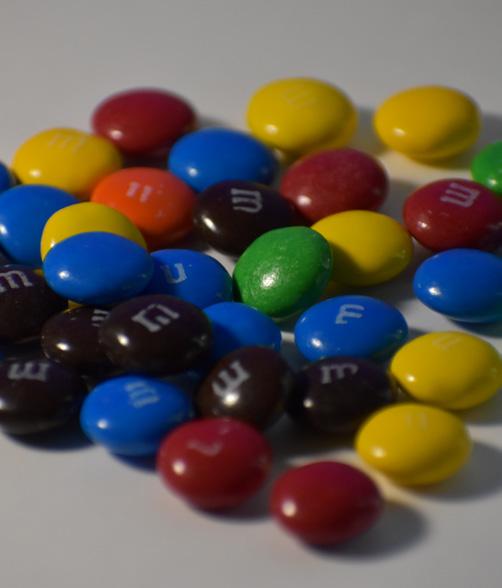

Monochromacy, or complete color blindness, makes all colors non-visible, and the person affected cannot see any hue or type of color.

g

A glimpse into the many different types of color blindness.
BallStateDaily.com is the online hub for all student media groups on campus. Stay up-to-date on the latest news, sports, community, entertainment and technology information through each unique student-produced media outlet.

